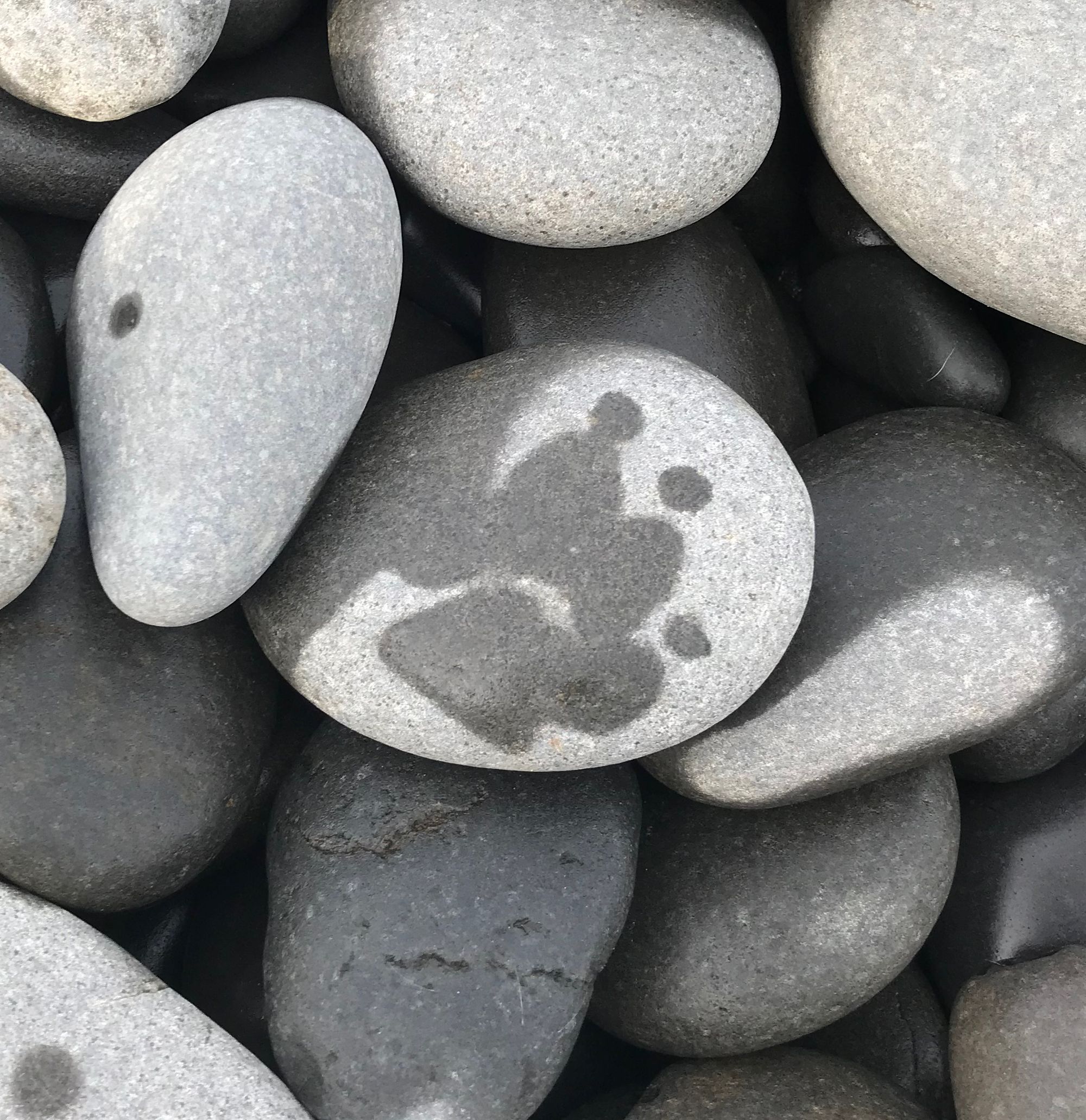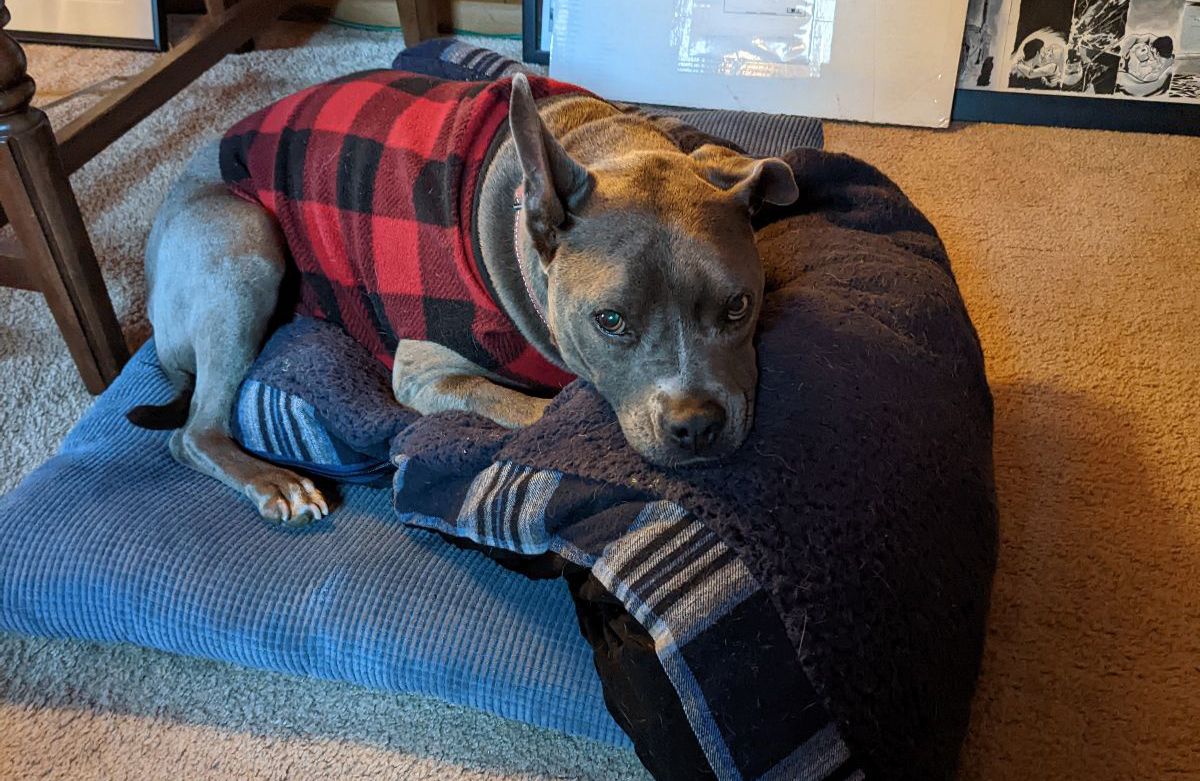Ooooh hoo hoo hoo hoo Essie Blue
This is a newsletter by Christian Sager that comes out every other Tuesday. In it I attempt to make sense of the sensory chaos I experienced in the world. I usually try to sort that information along the model of Maslow's Hierarchy of Needs. I don't do that this time.
This issue I write about the death of my dog Essie Blue in 6,000+ words and almost 100 photos. If you want to view the whole piece you may need to open it online outside of your email browser.

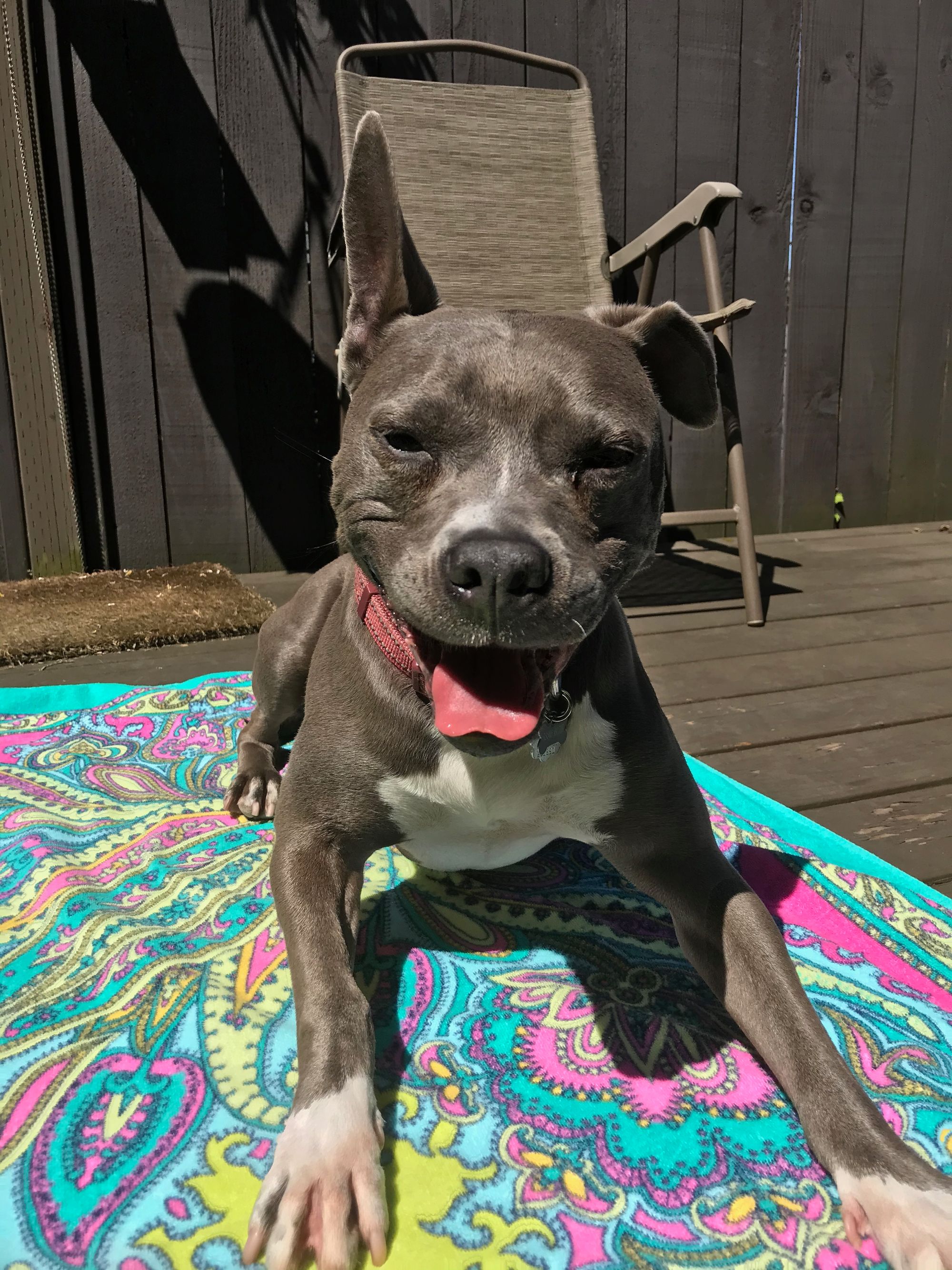
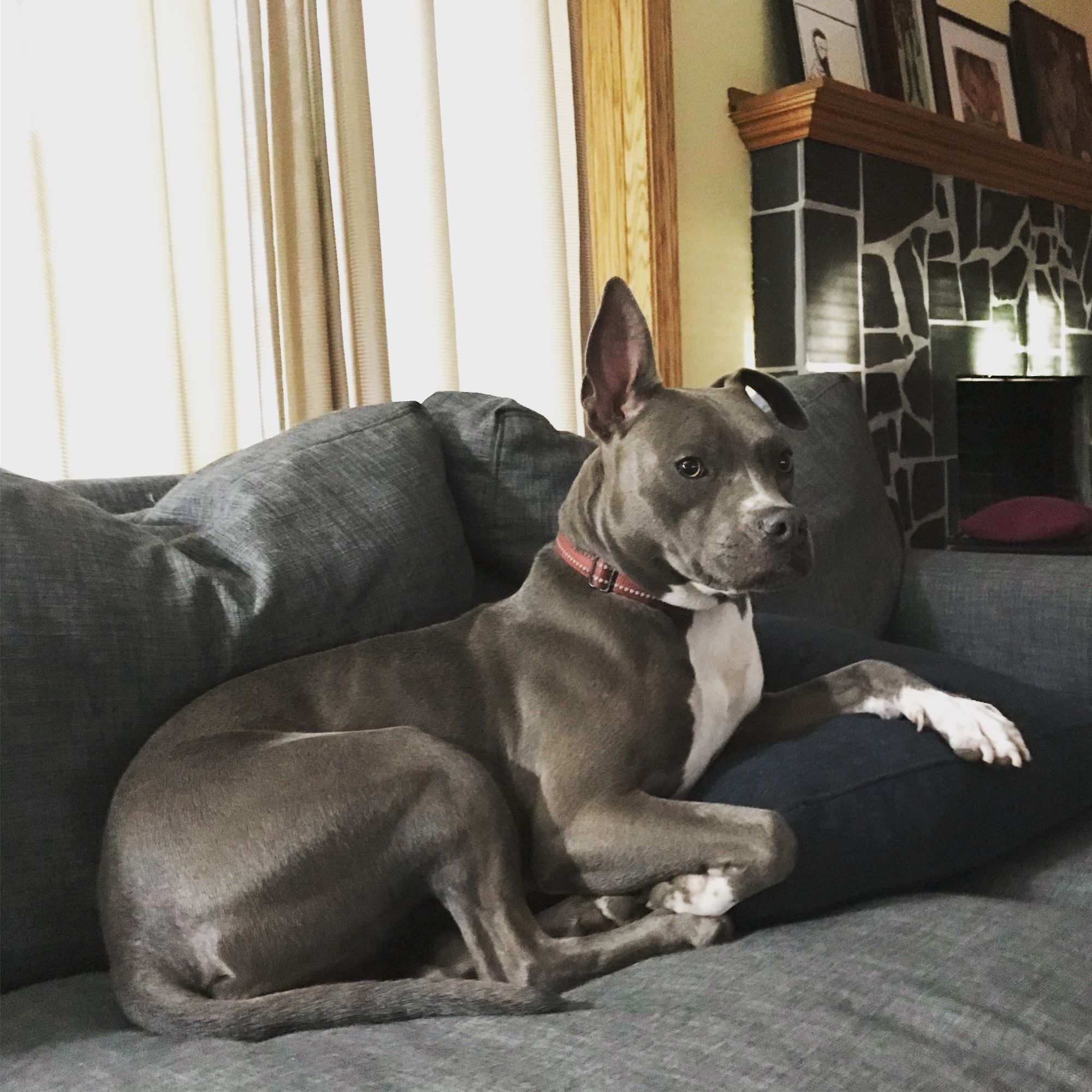


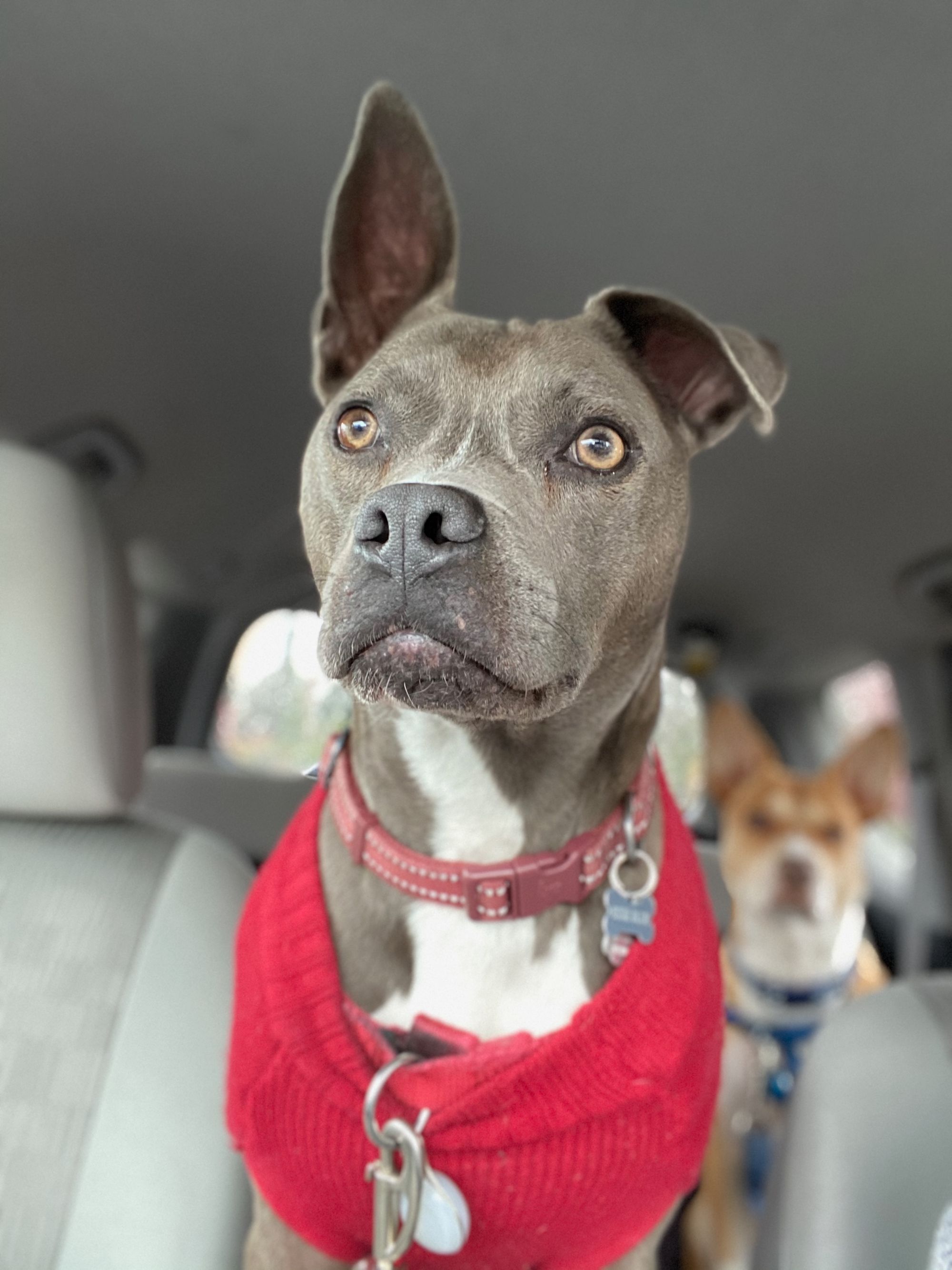
Like most pet owners we had a zillion nicknames for her: Blue Dog, Big Blue, Blue’s Clues, Bag of Rocks, Blockhead, Xenodog, Juggernaut, Little Panther, Ladykins, Punkin, Blueberry, Princess Muddy Paws, Sweet Girl, Clever Girl, etc. There were so many nicknames that one of her dog trainers got confused and told us, “You have to stick to just one name” or else Essie Blue wouldn’t understand our verbal command signals.
Whenever I called her “darlin’” it made Kelly happy, because she could hear the genuine love in my voice. Kelly herself had a song for the Blue Dog, to the tune of the chorus to The Ozark Mountain Daredevils' "Jackie Blue."
It went: “Ooh hoo hoo hoo hoo Essie Blue.”
She first came to live with us in early 2016, at our apartment in Decatur, Georgia. A hard luck case from day one, we think she was a 1 year old pit bull/boxer mix. Sometimes people refer to dogs like her as “pocket pitties” because of their size. Someone found her out walking around, freezing in the snow one January night in Decatur and brought her to the Laskey’s Lucky Ones shelter. Kelly had been looking at shelter sites online, wondering if we could foster a dog to see how Winchester would do with a companion in the house. A day later she was in our living room, bouncing around and full of love. Laskey’s called her Elsie as she was found in the snow and it was close to Elsa from Frozen.
Those first few weeks she was emaciated, stinking from mange and infections in both her ear and nose. Her fur only grew in patches. Her paws were swollen like baseball mitts. Laskey’s vet deduced that she’d been tied down for an extended time to a short lead on a block of concrete. By pushing against its hard surface she’d inflamed her poor feet. I forgot just how skinny she was when they first brought her to us, but it became obvious again when I started looking through our photo albums for this piece. Laskey’s eventually located her owner, but when they contacted the address, the person who answered the door told them, “Keep her.” She wasn’t wanted.
That first night we were supposed to crate her, but she climbed into our bed and perched right on our pillows like she’d always been there. So we caved in and let her stay there all night between us. The fostering lasted several weeks. It wasn’t easy; she barked perpetually when left alone, especially in the crate. And we quickly learned how overactive she was when she nipped Winn’s ear during playtime and drew some blood.
Still, she was so weak she was unable to do a lot of things puppies do. We lived on the second floor, but she was scared to walk up and down stairs. So I had to carry her every time we went outside for a bathroom break. Whoever tied her down didn’t bother to potty train her either, so she thought concrete was where she was supposed to go. It took weeks just to teach her to get on grass or dirt instead.
Laskey’s gave her girly dog clothes, like bright pink hoodies and sweaters to help cover her skin while it healed from the mange. Later on, an unsuccessful adopter tried to dress her in a Princess Leia costume. None of that fit her personality. Despite being the sweetest girl you ever met, Essie projected a tough thug-life vibe. I always preferred her in argyle or skulls & crossbones. But we put her in their outfits and brought her every weekend to the PetCo in Edgewood, Atlanta. They’d place her outside in a cage with the other adoptable dogs. In retrospect it’s silly to even think we indulged that idea. She was always going to stay with us. And she knew it.
We had already planned on a March vacation to Portland, Oregon, one of the locations we were scouting as a new place to live. Just before our departure she was adopted. We were happy for her, but reminisced about her on our trip. A week into our vacation Laskey’s called.
She’d chewed through a bathroom door and her adopter didn’t want to keep her. Kelly and I had just had a big argument — over something stupid I can’t remember, but Kelly says it was about the rental car. The phone rang while we were sitting in that car, outside the Subway at Cascade Station, trying to make up.
We decided to adopt and keep her. Shortly thereafter, we decided to make Portland our home.
When she died, my mother-in-law told Kelly, “You and Chris took her on when no one else wanted her.”
Ironically, that same location where we got the call was where we often took her and Winn for walks these last four years, because it was near the airport and most people didn’t walk their dogs out there. She loved it, stepping into brambles, finding dead birds and smelling all the scents the coyotes, squirrels and rabbits left behind. Maybe she knew that’s where we decided to keep her. On Thanksgiving, the day after her death, we took Winn out there for a sunny walk in her honor.

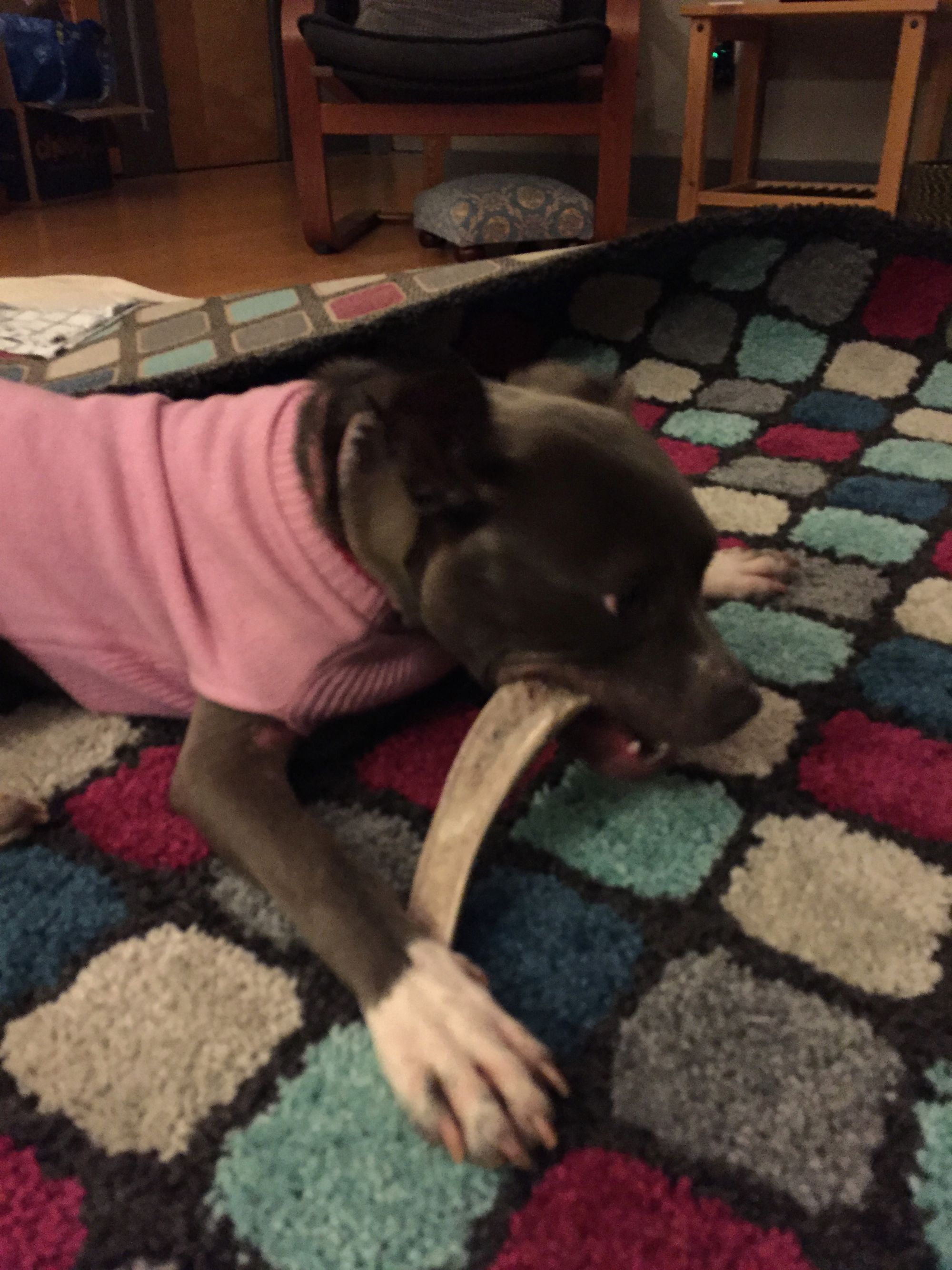

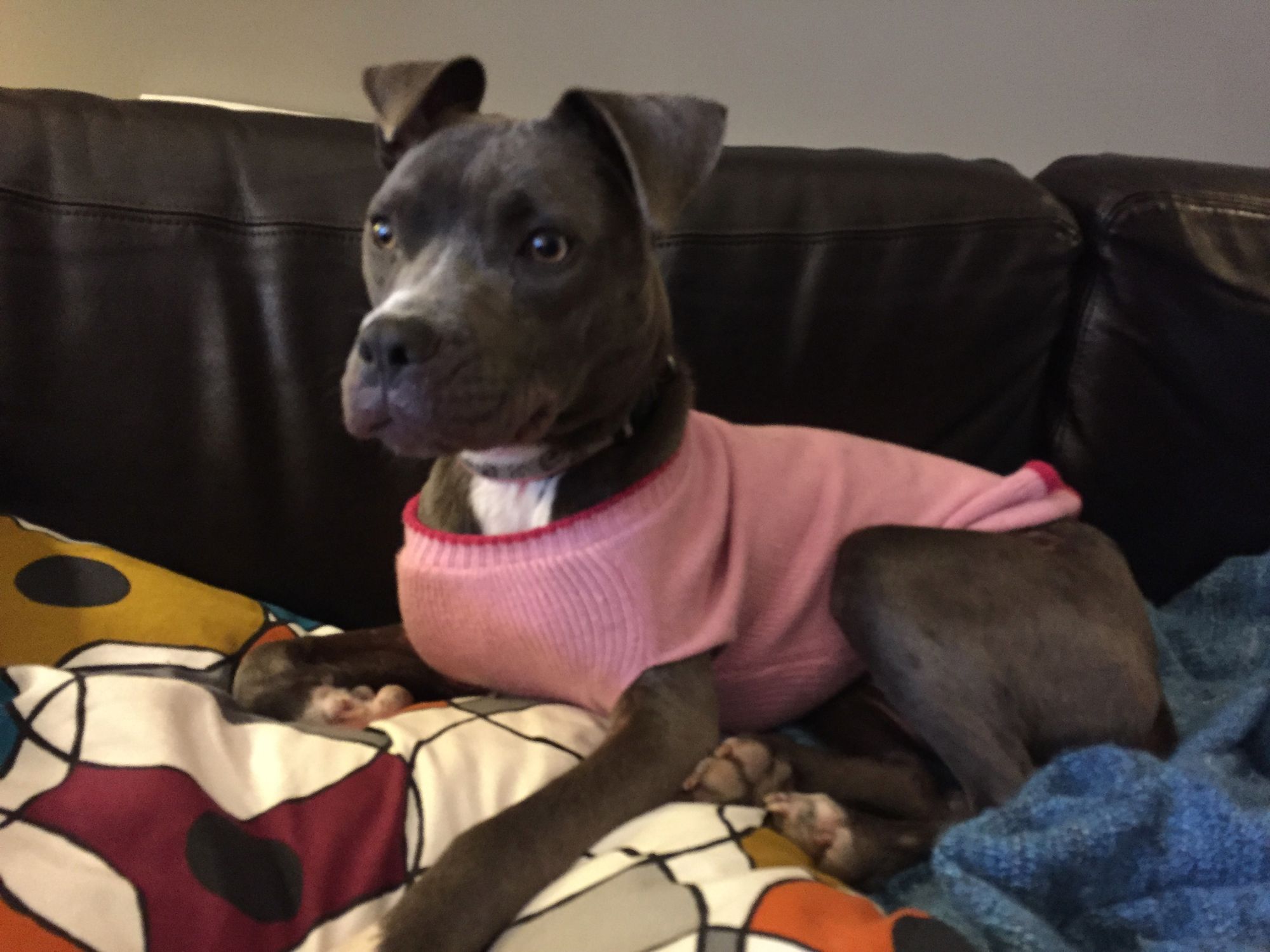
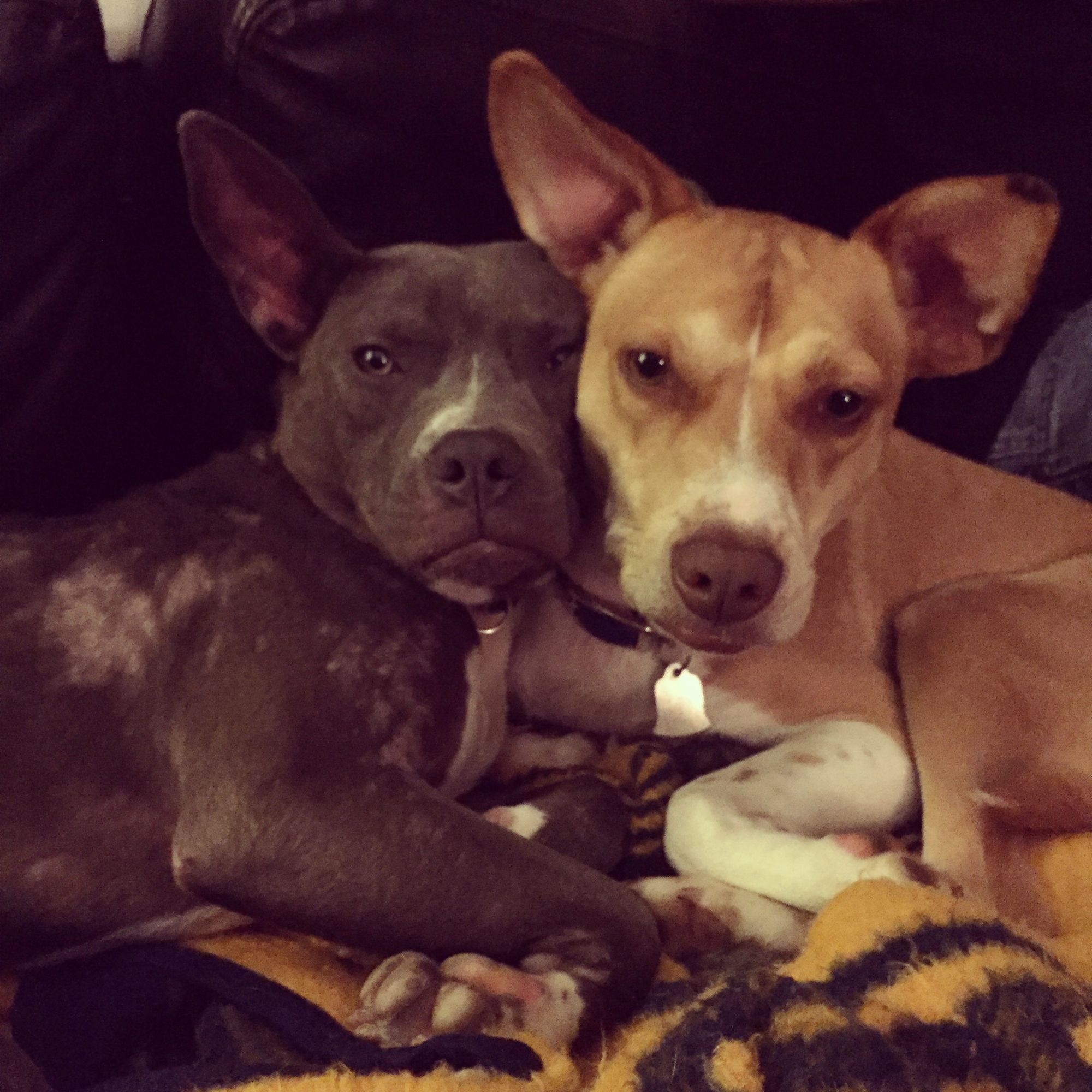



So we renamed her Essie from Elsie and I added Blue in honor of my grandparents long-gone border collie Terry Blue. I briefly had some silly notion that both our dogs could be named after counties in England if we claimed that Essie was short for “Essex.” But we never really called her that.
You’ll see in the photos here how she went from a scrawny, abused puppy to a full-operational, shiny, musclebound tank of a dog. She knocked me flat on my ass on several occasions. Her impact was so tremendous that I can’t believe she only lived with us for a little over six years. Half-a-year Decatur. Two years in Edgewood, Atlanta. One year in Vancouver, Washington. A bit over two years at the Little Orange House in Northeast Portland. And finally, half-a-year at our recently bought home in St. Johns, Portland, Oregon.
We gave the veterinarians permission to euthanize Essie Blue around dusk on Wednesday, November 23, 2022. Complications from lymphoma had swollen her lymph nodes so large that it was difficult for her to breathe and she wouldn’t eat anymore. She’d been in intensive care for three days.
Here’s the crash course I was forced to learn about dogs, cancer and lymphoma in particular: A third of dogs get cancer. Lymphoma however can sometimes be treated with a form of chemotherapy called Elspar. But here’s the hitch… if the dog is given prednisone as a first response, it can weaken the effectiveness of Elspar. This is what happened to Essie.
In the summer she had a lymph node reaction. Our vet aspirated them, but there was no sign of cancer cells. So we gave her a combination of antibiotics and prednisone. A few weeks later it cleared up. Shortly after that her right nostril ran mucus uncontrollably. After even more antibiotics we scheduled a rhinoscopy with an internist, who determined she had a bacterial infection that included E. Coli. He prescribed even more antibiotics and her nose started to clear. When she stopped eating we assumed it was just nausea from all the meds. But then we found a tumor on the gum of her lower jaw. We booked the vet on a Friday for a Monday. Over the weekend she began struggling to breathe. Our vet sent us straight to an emergency oncologist, one of the best in the country, from a family of canine oncologists. Several times he told us, “She’s a complex case. This is a very sick dog.” I later learned from Joan Didion that this is code for “the patient is dying.”
We couldn’t figure out how to make her feel better. Neither could four different veterinarians.
We hate that Essie was alone in the hospital for most of her last three days. When the anger stage of grief takes over, we blame ourselves, as if we had any other choice. Kelly and I sat in that hospital’s lobby for probably twelve hours, just thirty feet away from her, with two walls between us. I would have climbed into the enclosure with her and stayed round-the clock if they’d let me. Instead, I’m left hoping that she could sense we were there, nearby and with her, so she could at least rest knowing we stood guard.
I learn something from every one of my pets. Each of them changes me, at least twice. I become a different person when they enter my life. This revision happens again when they’re gone. I don’t know who I’m going to be yet without Essie Blue here. So far he feels older, slower and more melancholy.
Ours is a family of survivors. Each of us — human and pet alike — were forsaken by where we came from. Together we’re just trying to get by in this shitty world. Kelly says, “We let them be with us — and be themselves — because we know better than anyone what it’s like to be rejected for who you are.”
My sister once told me, “Your dogs are like y’alls’ kids.”
Kelly frames it differently. She says they are literally a part of us. Not just emotionally, but physically as well, because our environment is steeped in their dead skin, fur, farts, etc. We breathe them in and they become us.
All of us in this house survived trauma. Losing Essie is another wound to add to our trophy case, a psychic scar left behind from her death. In honor of all she survived, we’re trying to survive this too.
Kelly says, “Maybe that’s her gift to us. Now Thanksgiving no longer has to be a miserable holiday for us because of our dysfunctional families. From now on it’s about Essie.”
(By the way, if you ever want to re-solidify your relationship with your partner, try scrolling through all of your private message threads over the last 7 years, looking for photos you sent each other of your dog. It’s amazing how much we’ve been through.)
Here’s an incomplete list of everything we survived with Essie and our other living pets: Kelly getting laid off, the 2016 election and all of Trump's presidency, my getting let go from HowStuffWorks, our move across the country, two more frustrating jobs I had to quit, the death of my grandmother, the COVID pandemic, 17 months of unemployment, the 2020 election, the 2020 Oregon wildfires, the 2020 Portland police protests, our choices to purposefully distance ourselves from our families, the January 6th insurrection, the 2021 Heat Dome, buying a house in a crumbling market, and me… foolishly trying to publish a horror magazine in the middle of all of it.
Crisis after crisis.
Writing pieces like this is how I process grief. I’ve done it for every one of my pets when they died; six as of now. It never gets any easier, especially when you have to make the choice to cease their life to bring an end to their suffering. Every single time it feels like you’re doing the wrong thing.
Other than writing and time, what’s helping is what I’ll call a “grief enema.” Here’s what you do. Start by watching the season finale to HBO’s The Vow right before bed. Have awful nightmares. Then crawl into the shower so you can bawl to a playlist of sad memorial songs. Somewhere between Sia’s “Breathe Me” and Johnny Cash’s “Hurt” you can leave a little room to catch your breath between the tears. Neko Case’s “Hold On, Hold On” makes a good respite.
Actually, there is one other thing that’s helping. I mentioned Joan Didion earlier. I’ve been reading The Year of Magical Thinking, about her experience processing grief when both her husband and daughter died. Auntie Joan begins by conducting a literature review of grief and how we’ve come to scientifically understand it. Here are a few things she’s taught me so far.
Going back to Freud in 1917 we’ve recognized that grief is a peculiar derangement, because it never occurs to our modern culture to regard it as “a pathological condition and refer it to medical treatment.” In 1940 Melanie Klein took this a step further by stating, “The mourner is in fact ill, but because this state of mind is common and seems natural to us, we do not call mourning an illness.”
Does your employer provide bereavement leave? Mine does. But nowhere in their policy do they identify a pet as a “covered family member.” And yet, according to Didion’s research, here are the known symptoms of grief: we stop eating, we forget to breathe, we grow faint from lowered oxygen, we clog our sinuses with unshed tears, we lose cognitive ability. Sometimes we even fall sick, fail, and die.
I’m not ashamed to admit that I’m grieving Essie Blue more than I did my own grandmother. I suspect there are only a rare few humans I’ll mourn this vigorously.
Didion’s research revealed another observation: that we separate “uncomplicated grief” from “complicated grief.” The former is considered normal bereavement. The latter is diagnosed as pathological. It usually occurs when “a survivor and the deceased are unusually dependent on one another.” This pathology leads us to all sorts of serendipitous thoughts that are often dismissed as woo-woo spirituality. These are “the-universe-is-providing-me-meaning” type beliefs and they’re the magical thinking referred to in Didion’s book’s title.
If it’s not clear by now, Essie Blue and I were dependent on each other. Very few of you got to know her, either because of physical distance or her reactivity. So I’m going to use the rest of this space to introduce you to her and what I learned from her. Maybe along the way I’ll share some of my own pathological, magical thoughts.


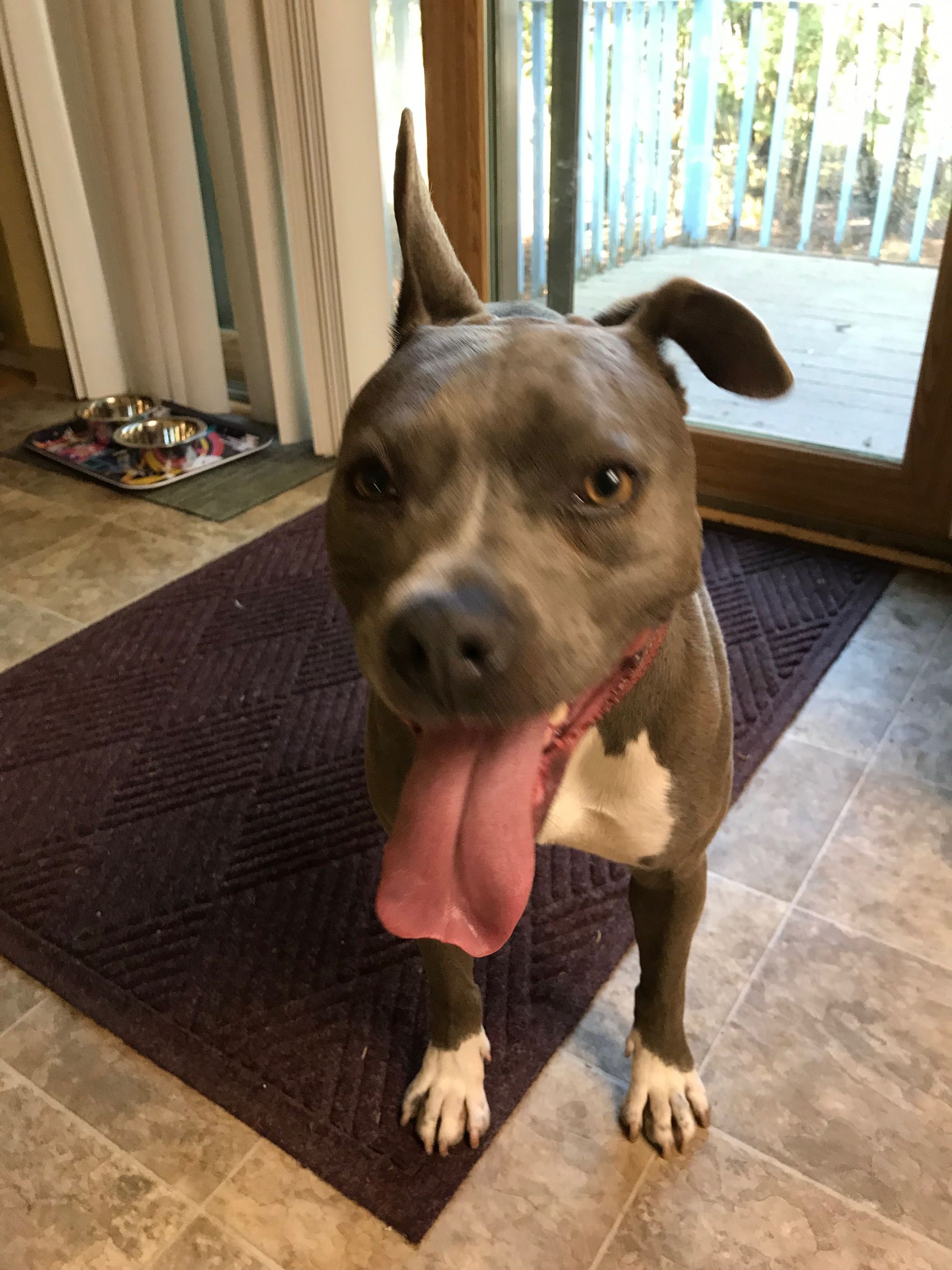
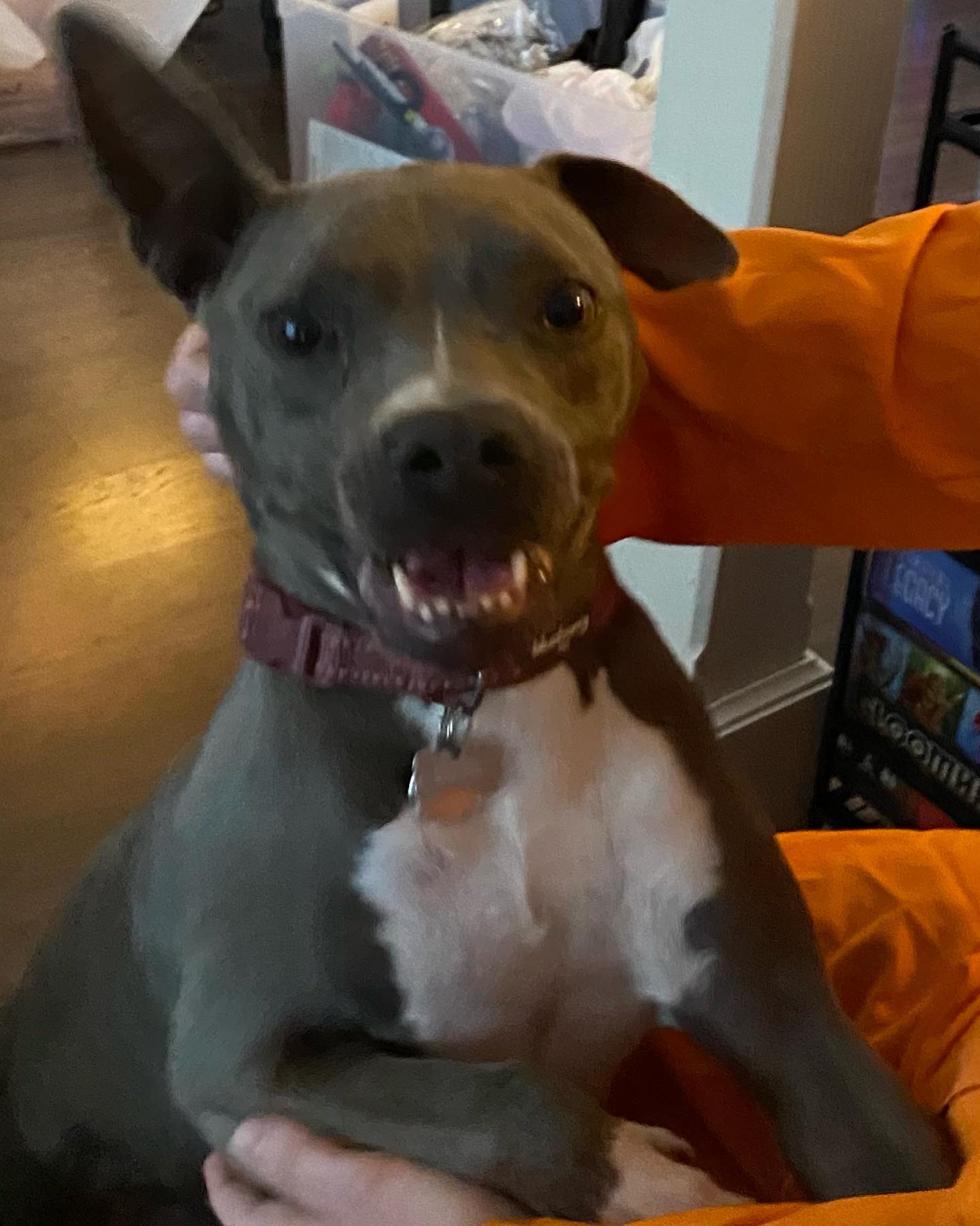

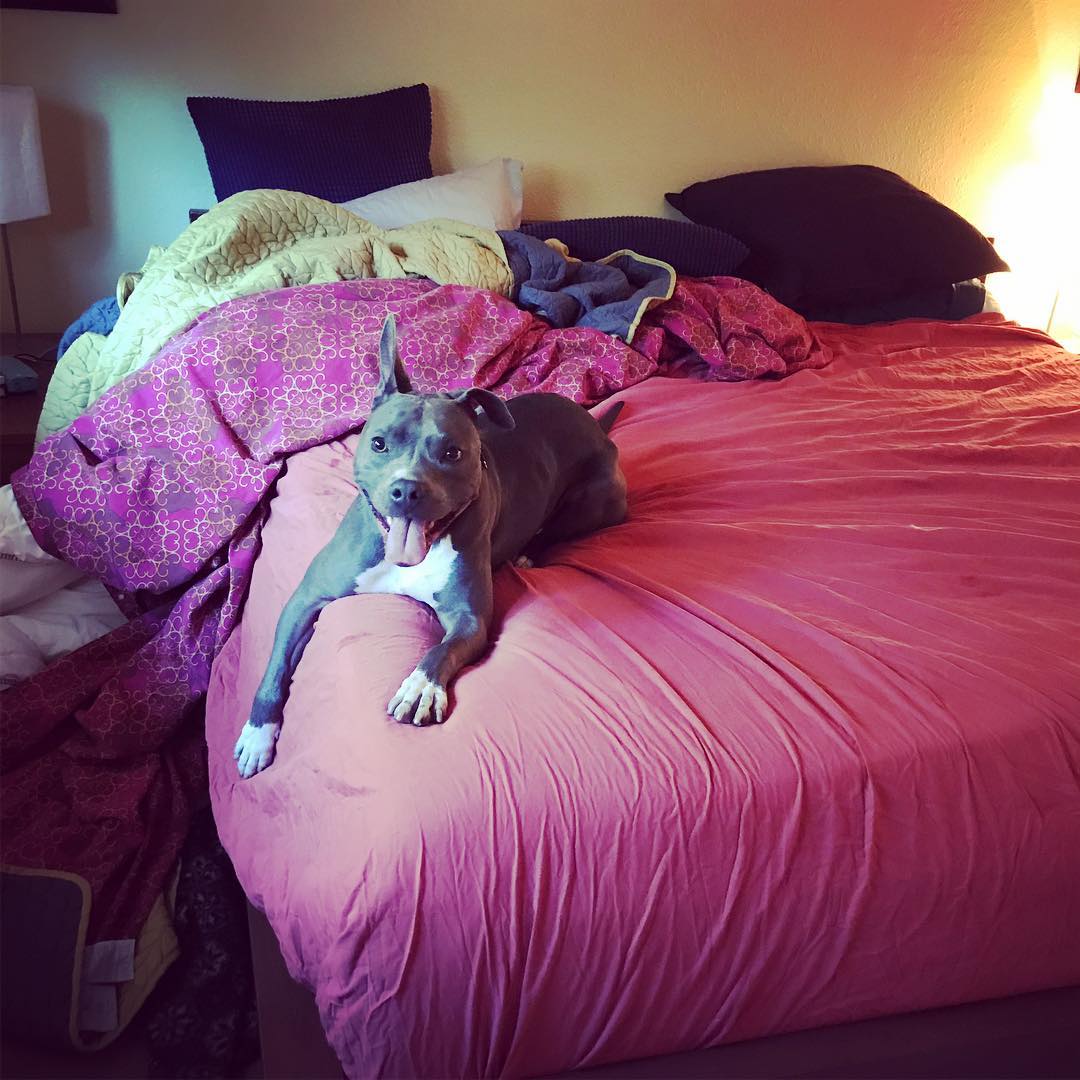
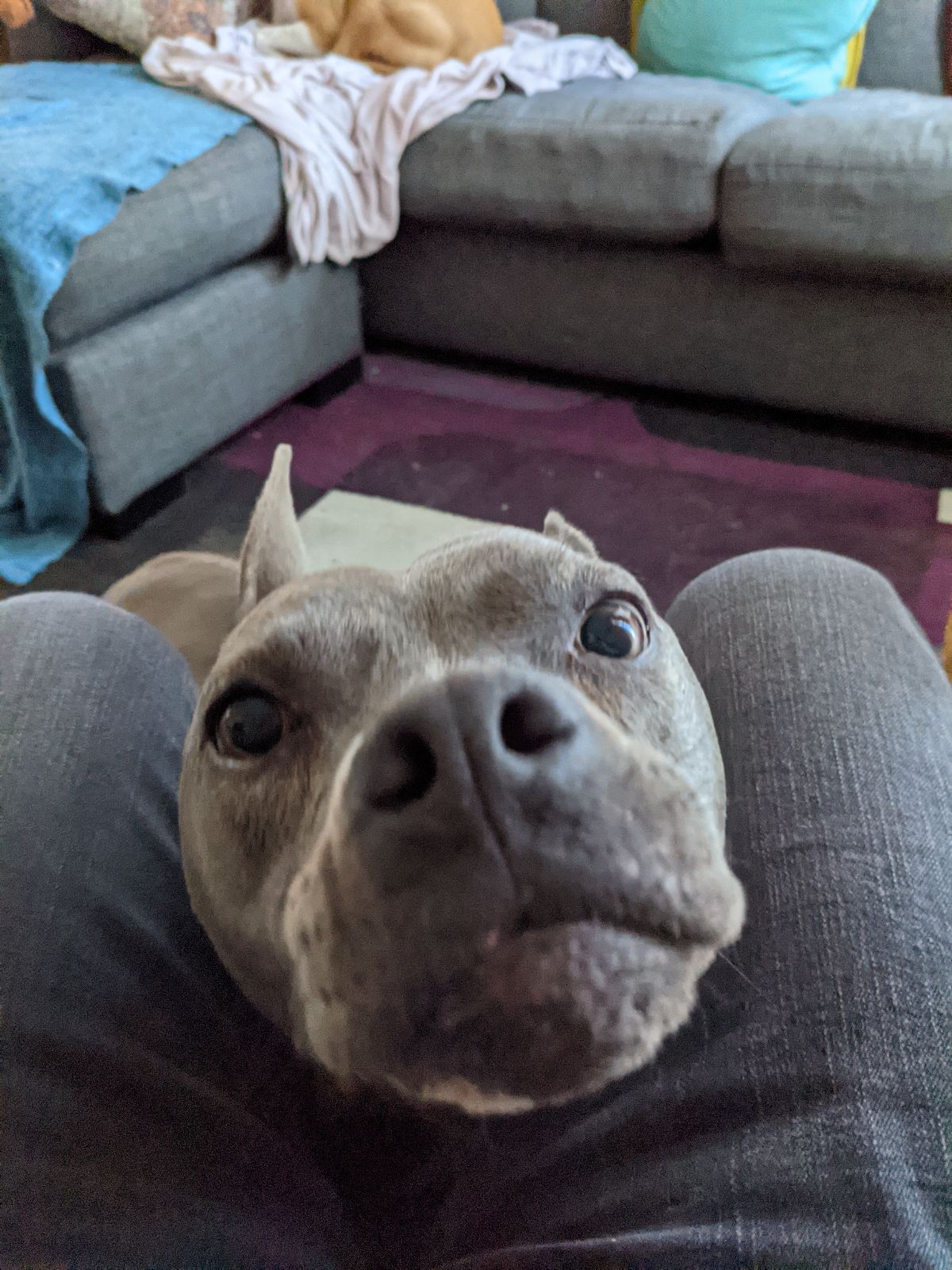
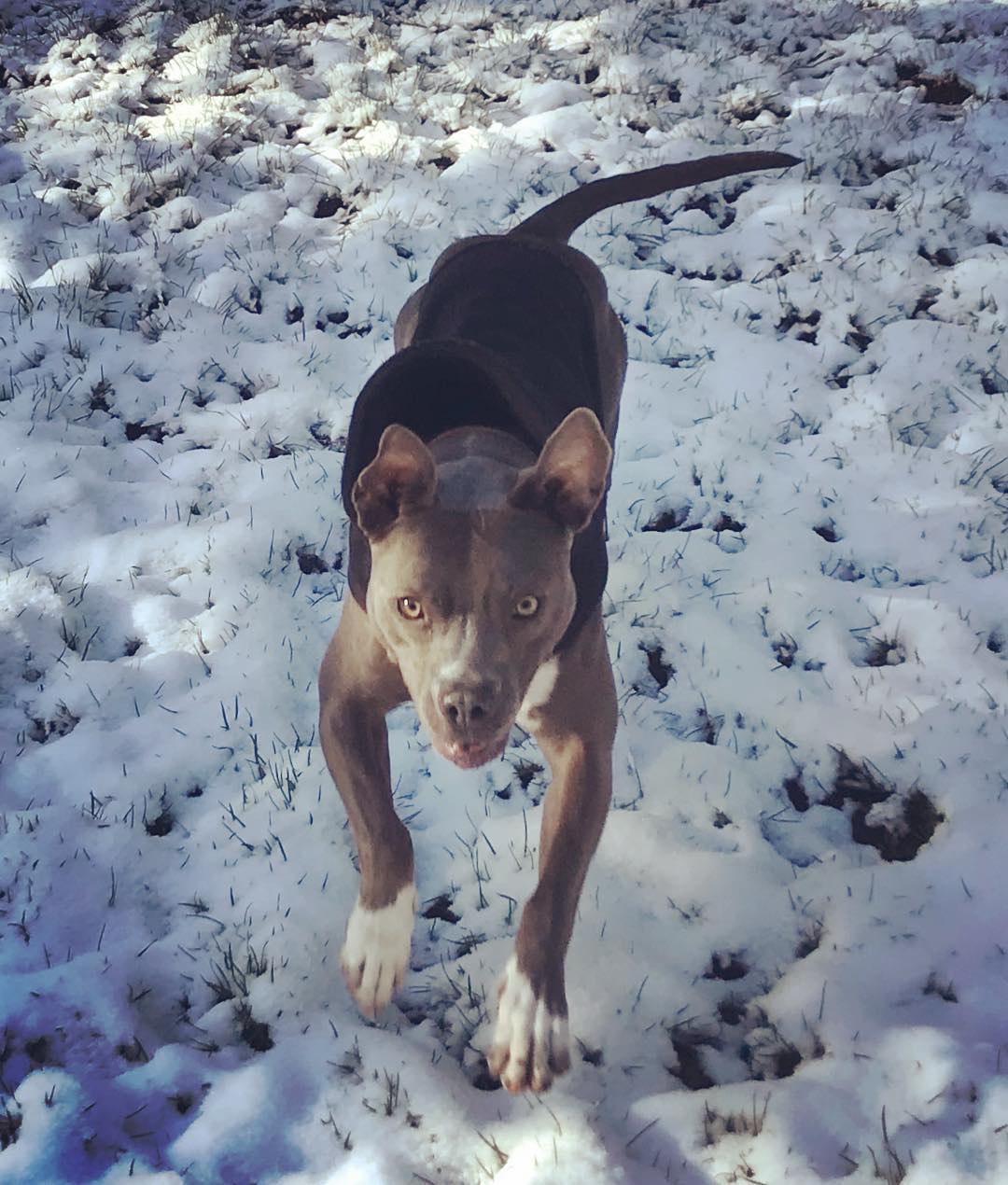

Essie Blue was what my therapist refers to as a special needs dog. Reactivity wasn’t her only complication, but it was the issue that required the most attention. Whole Dog Journal defines reactive dogs like this:
There are two distinctly different types of reactive behavior. One is caused by fear or anxiety and commonly includes a significant risk of aggression. This usually presents in dogs who were not well-socialized, who are generally fearful or anxious, and/or who have perhaps had life events, whether accidental or deliberately abusive, that now cause them to be particularly sensitive to the stimuli that are triggering their abnormal levels of arousal.
The other type is caused by frustration. An example would be the dog who is very eager to interact with the other stimulus – often another dog – but is thwarted from doing so by a leash, fence, other barrier, or physical restraint by a human.
Essie demonstrated both of these types of reactive behavior. Winn had already trained at a place called Pets Playhouse on Ponce, where he also attended daycare when we were at work. About two days into her tenure there, Essie had to be isolated from the other dogs and we were told she could not return. “You have a reactive dog on your hands there,” said the owner’s son.
We were naive when we first got her and tried taking her to dog parks or to meet our friends’ dogs (sorry Frida and Charlie). Inevitably she’d get too excited, upset another dog with her behavior and get into a scary tussle with them.
Laskey’s Lucky Ones paid for us to train her at a school in Decatur called Frogs to Dogs. We went through months of classes, taking her down there early every weekend. She made a little progress, but most of it was to no avail. She was great at simple commands like sit, touch and down. But the minute another dog got within twenty-feet of her, she went ballistic. Kelly described it like this, “Her little brain was on fire.”
It wasn’t until we moved across the country that we were able to hire an individual dog trainer to come to our home and work with her. Carmen LeBlanc from Way to Behave offered two classes for dogs like Essie. “Reactive Rover” is for dogs that bark, pull, jump and lunge at other dogs. “Cautious Canines” is for rowdy, jumpy, mouthy, impulsive, high energy, excitable and out-of-control dogs. Those checked all of Essie’s boxes. And after five weeks of working with Carmen I wrote this review for her online:
Carmen easily identified our dogs' behaviors, listened to our specific concerns and diagnosed an appropriate training plan after each session. We also really appreciated how her training methods are all humane, with positive associations for everybody! Not only do I feel like I'm more prepared to handle my animals, but I also feel like I understand their needs better.
What I meant in that last sentence was this: I realized that Essie and I were both survivors of abuse. We were both anxious, because of deliberately abusive life events that caused us to be sensitive to triggering stimuli. We both reacted to fear with anger. Together, we could try not to. Her reactivity was so similar to my own that I learned to understand what triggered us both and why.
When she died, one of my colleagues texted me this: “For those of us with shitty childhoods and primary attachments to our animals, it's just the worst.”
Essie didn’t like skateboards or bicycles any more than she liked other dogs. When she’d bark relentlessly at them it seemed like she was trying to yell, “That’s not natural! Get off that thing!” Either that or she just really wanted to try to ride them herself.
When we went for car rides Essie would get so upset about viewing other dogs, skateboards or bikes that we encouraged her to lay down on the floor in the backseat to block her line-of-sight. She got to a point where she did this naturally, just happily dozing along to the rumble of the auto parts underneath her. When she’d wake though she’d kick out forcefully, thumping the backs of our seats.
Because of her reactivity, not many people got to know her well. We couldn’t really bring Essie Blue anywhere without an incident. Kelly told folks, “She’s a lot of work. But she’s worth it.”
We were so similar that we sometimes rubbed each other the wrong way. Once we went for a walk in the freezing rain on Alberta Street. She lost her mind when we passed a dog just chilling with its owners by a fire at the Knock Back. In her eruption of enraged barking I tripped ass-over-teakettle onto the wet sidewalk. Together we walked home silently, each frustrated with the other.
I wasn’t the only one who had incidents like this. We tried to be really good on walks about spotting other dogs, so we could cross the street and duck behind cars to limit her line-of-sight to them. During one of these escapes, Kelly tripped, fell over Essie and smashed her face into the sidewalk, breaking a tooth. “Everytime my tooth aches I’ll think of her,” Kel says.
Essie bit me several times over the years, usually when I had to pull her away from other dogs. This was as much my fault as hers. She picked up my tension and lashed out at whatever was nearest. With every bite she pulled away immediately, letting go the second she realized she’d caused me pain.
Once, when we were still living in Atlanta a contractor started fixing our electric gate without letting me know they’d arrived. Unaware a stranger was in the yard, I let her out to pee. She came at him so fast he ran for his life and vaulted over the fence.
Despite all of this, we did get her to a point where she tried to regulate herself. It wasn’t easy for her and she’d sit and groan — brain on fire — trying her best not to bark. Once the coast was clear she’d let out a yawning moan instead, to dissipate her pent up energy. If we were home and she got triggered, she learned to quickly find a squeaky toy and repeatedly chomp it to work off the anxiety. The ones with squeakers sometimes went on for 20–30 piercing minutes at a time.
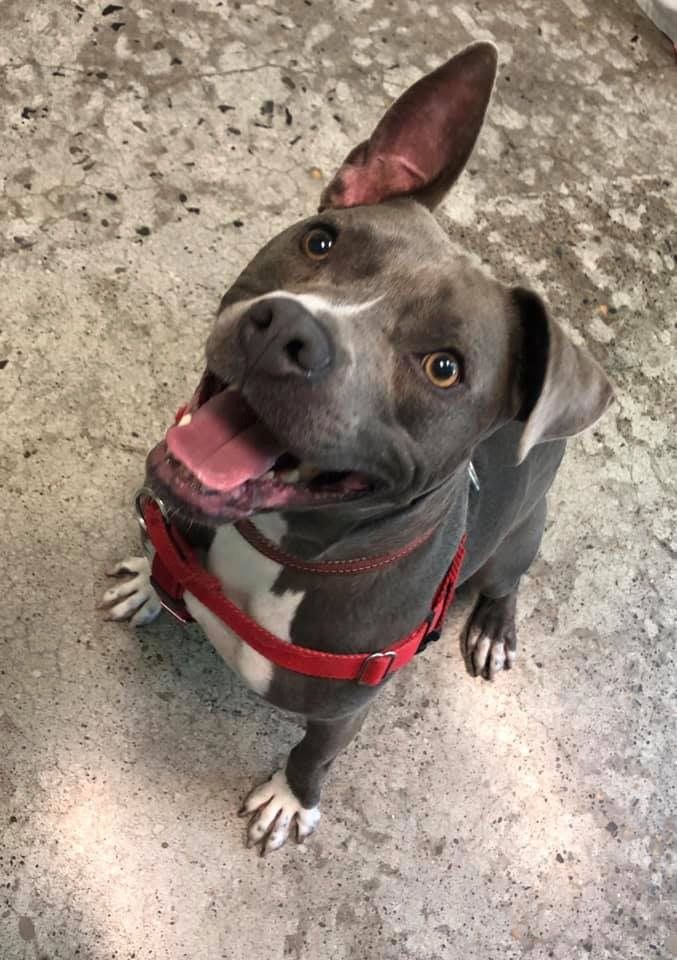
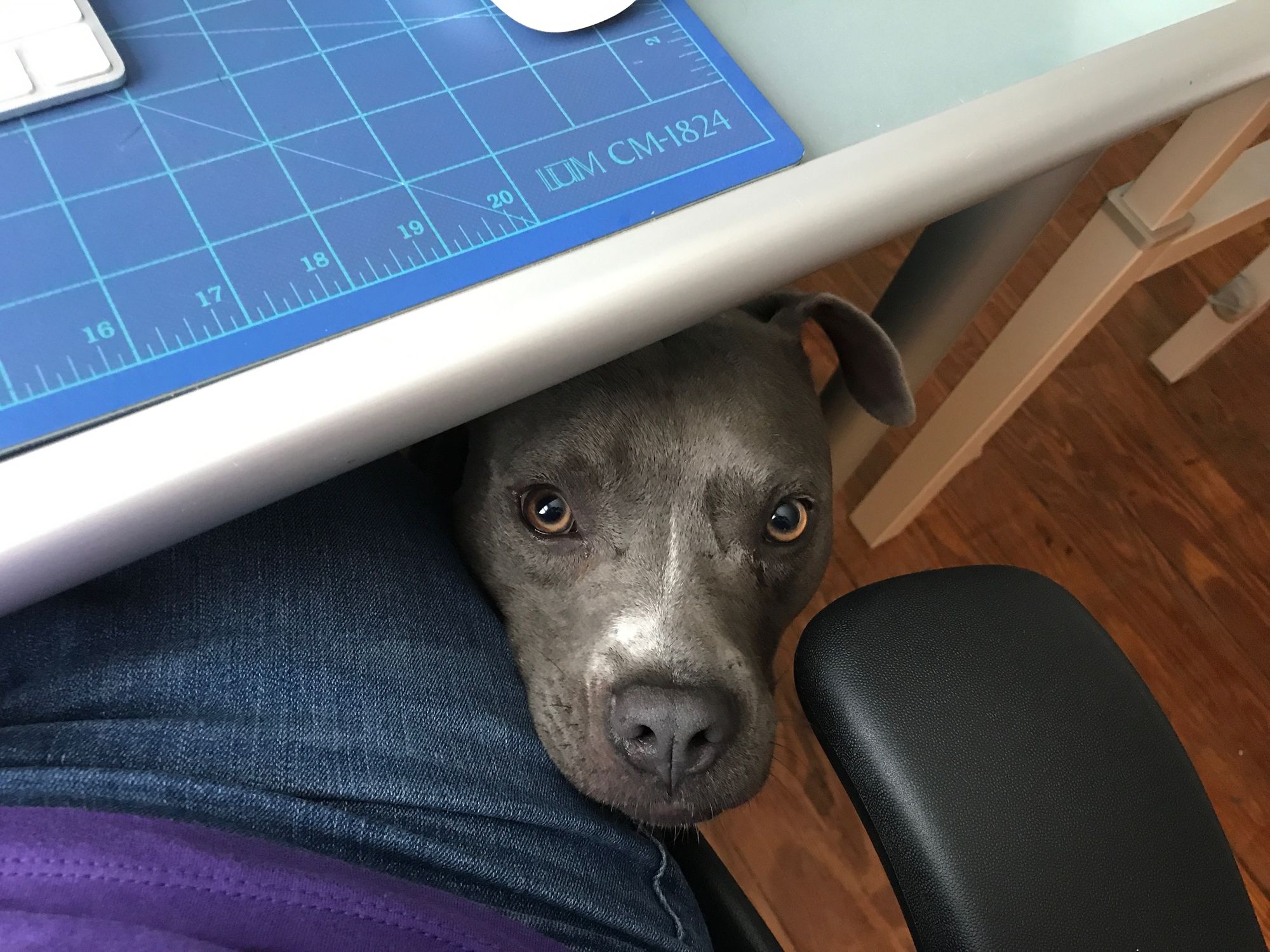

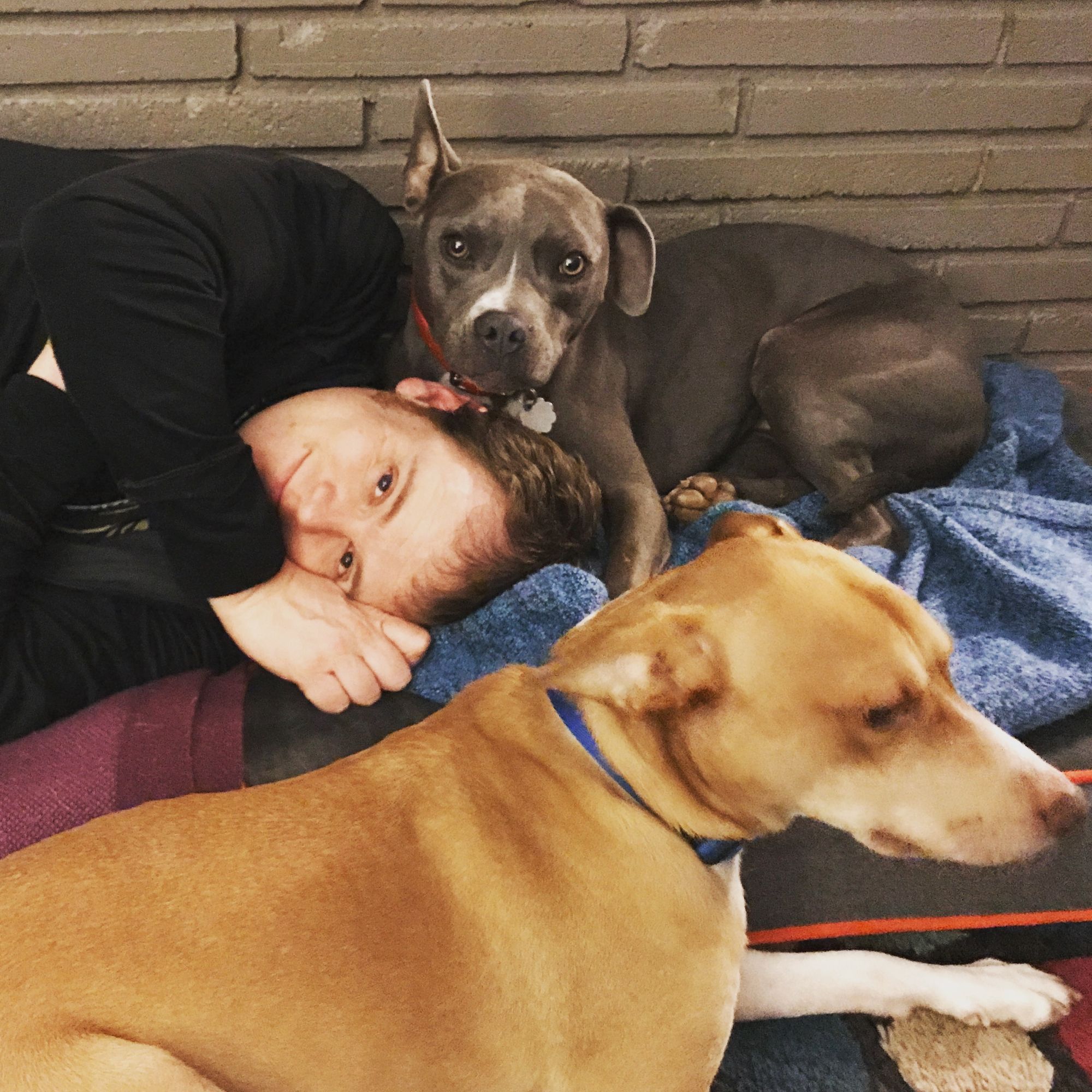
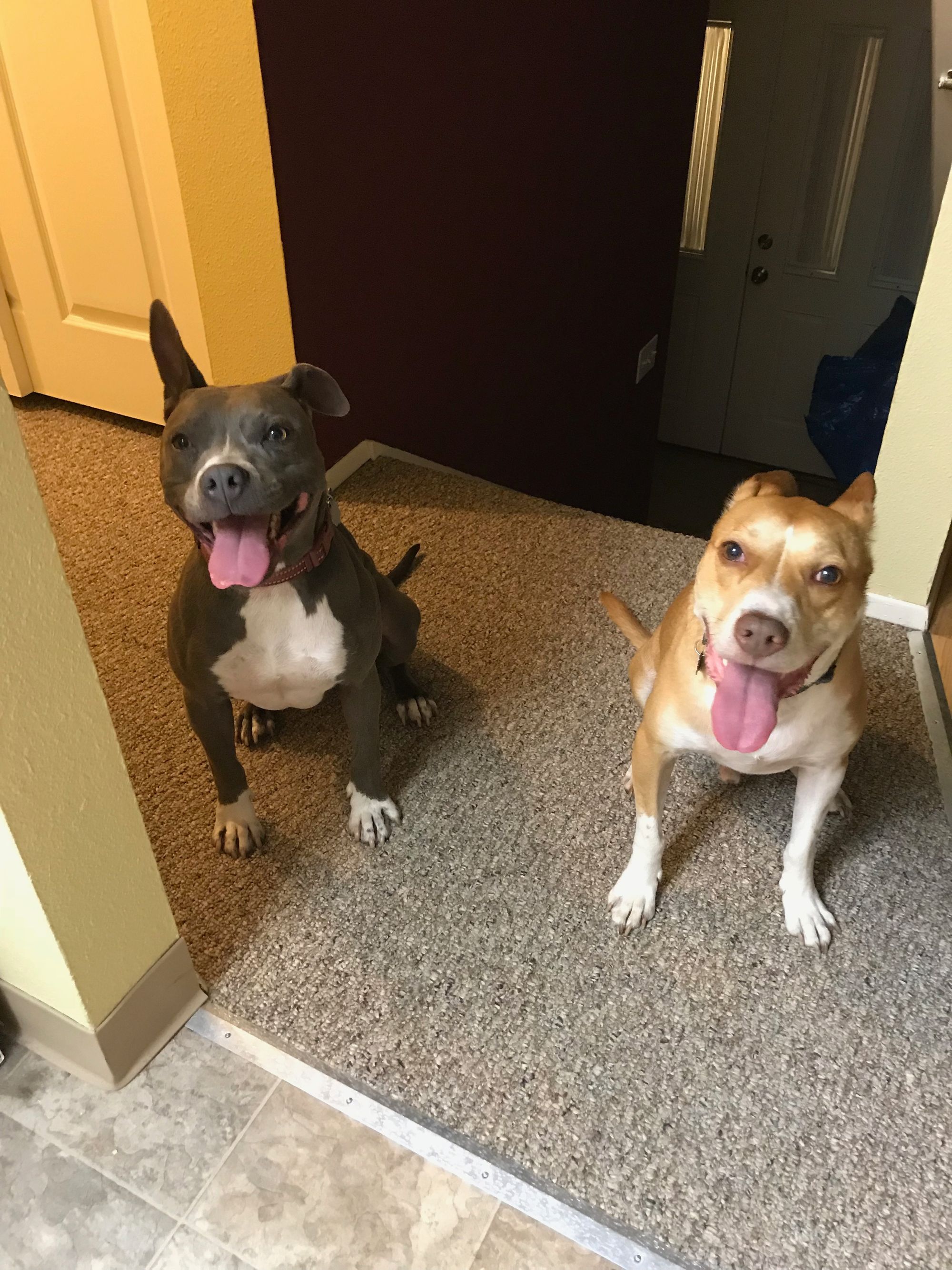

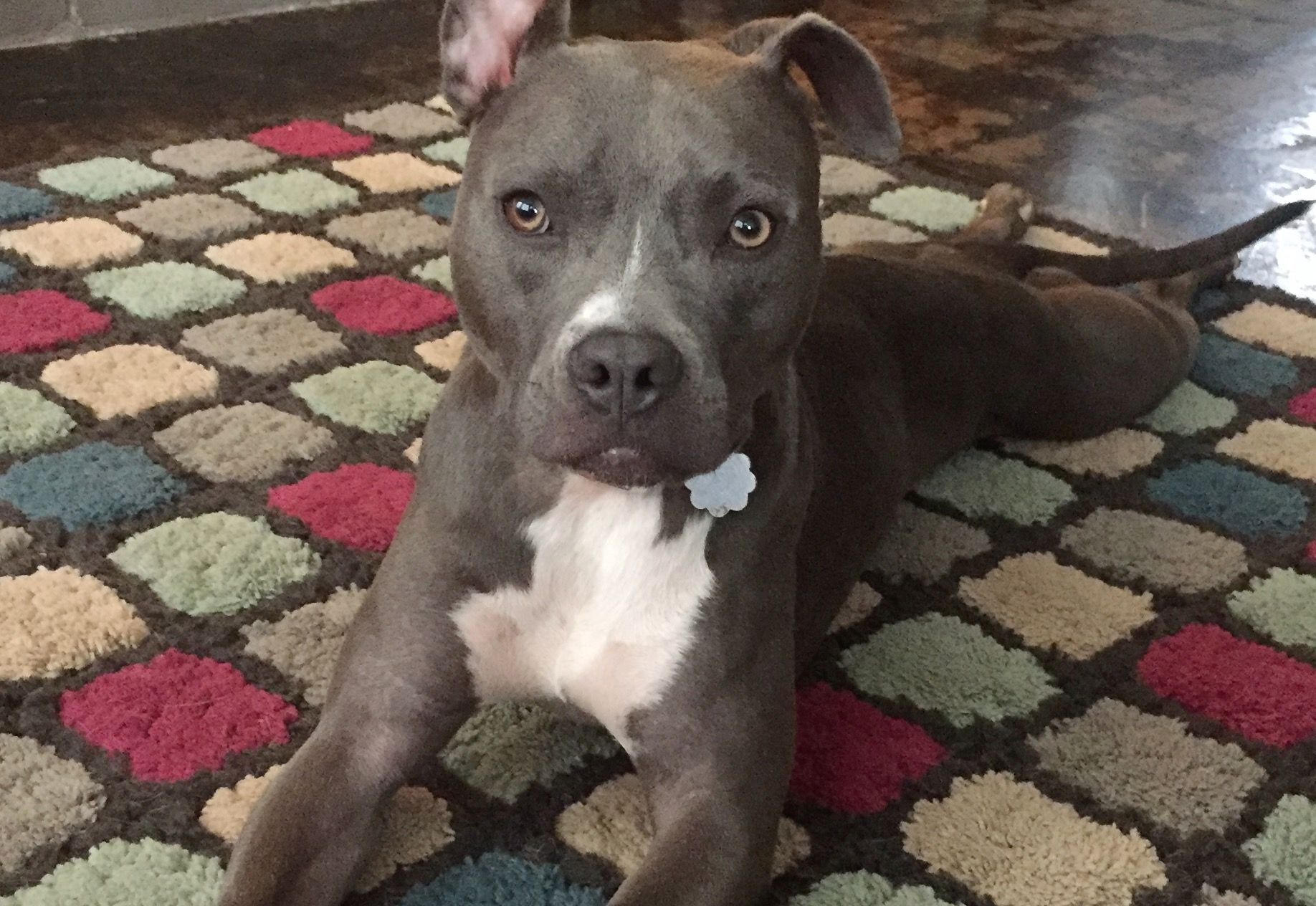


Folks, I know this is a long piece. I’m already breaking 3,000 words when I usually try to keep these between 1,000–2,000. But I don’t care. Kelly says, “She had a universe inside her. She deserves all the words.”
You may get a sense for what she was corporeally like from the accompanying photos. But I’d like to share some of her traits with you as well. To us they’re special.
Essie Blue had one floppy ear that never popped. It was the first thing people commented on upon meeting her. In fact, both her ears were floppy when she came to us off the street. One eventually rose, but she could never quite get the other to stand up all the way. Not unless the wind blew on her from just the right angle.
She had a big, thick, invulnerable head that she banged against objects on the regular. This barely phased her. She also burned hot, like a solar furnace boiled in her tummy. Our personal joke was that this was her “Hot Belly Creamery,” as opposed to the cold stone one for ice cream. You could probably cook food on her blazing stomach. No joke, the house feels physically colder with her gone. I’ve actually added a gravity blanket at night to make up for her absence, both physically and thermally.
That girl had a maniac look in her eyes when she got excited and she’d grin from ear-to-ear.
Outside of her barking, she had a distinct, but tiny voice. Whenever she’d try to get comfortable or scratch an awkward itch she released little old man groans. And like many pet owners we did anthropomorphized impersonations for her and our other animals. Essie’s voice was somewhere between a Powerpuff Girl, Lyana Mormont and X-23 from Logan. There were many pop culture characters that showed up in our lives where we’d turn to each other, nod, and simply say, “Essie.” Godzilla comes to mind.
In one of our chats, Kelly once described this little girl as Essie’s human avatar:
She was pushy. She pulled too hard. She was stubborn. It took years of training to get her to stop dragging us around like rag dolls. For only fifty-pounds of muscle, she brokered no quarter and always charged ahead.
Sometimes her back legs weren’t always as strong as her gumption, so we set a step stool up to help her climb into bed. Still, at the hospital, even when she was pumped full of drugs, had an oxygen feed in her right nostril and several stints poking out of her, she managed to jump on the gurney when they brought her to us in the hospice room. We helped her climb down and she shook herself off for composure. Even at her weakest Essie Blue refused to be infantilized.
Like many dogs, Essie had silent-but-nasty farts, usually when she was perfectly relaxed on the couch or in bed. She made us laugh a couple of times in our time together in the hospice room before she passed, but her funniest gift was to let out one last putrid fart when she died.
I took Winn out back for a bathroom break when I outlined this piece. Probably struggling with his own emotions, he got into a barking match with the German Shepherd next door. Essie despised German Shepherds; her nemeses. While bringing him back inside I accidentally stepped in dog shit and tracked it all through the house, right back up into my office. Sitting here typing this I noticed the awful smell and thought, “I hope it’s hers.”
Her tooted vapors were indicative of another characteristic. As tough and furious as she could be, Essie’s insides were very sensitive, probably leftover from that first year of malnutrition. She often got sick to her stomach and when she would vomit, it just fell out of her mouth onto the floor without projection. In retrospect, maybe we shouldn’t have given her as much french fries or whipped cream. But she loved them so much. And we loved to see her happy.
So it wasn’t uncommon for Essie to turn her nose up at food. We usually had a bowl of her breakfast waiting in the fridge, waiting for her to finally muster the appetite to eat it. This is why we didn’t think much of it when she wouldn’t eat for the first day or two. It had happened plenty of times before with no repercussions.
One of the few things she’d eat without compunction was peanut butter, which she knew as “dessert” because we had to slip her three pills with a spoonful every night. One was for incontinence. One was for skin allergies. Another was for anxiety. Yet another way we were alike; we took the same pill dosage of Prozac. Don’t tell my doctor but sometimes when I ran out before my prescription was filled, I’d borrow a few from the Blue dog.

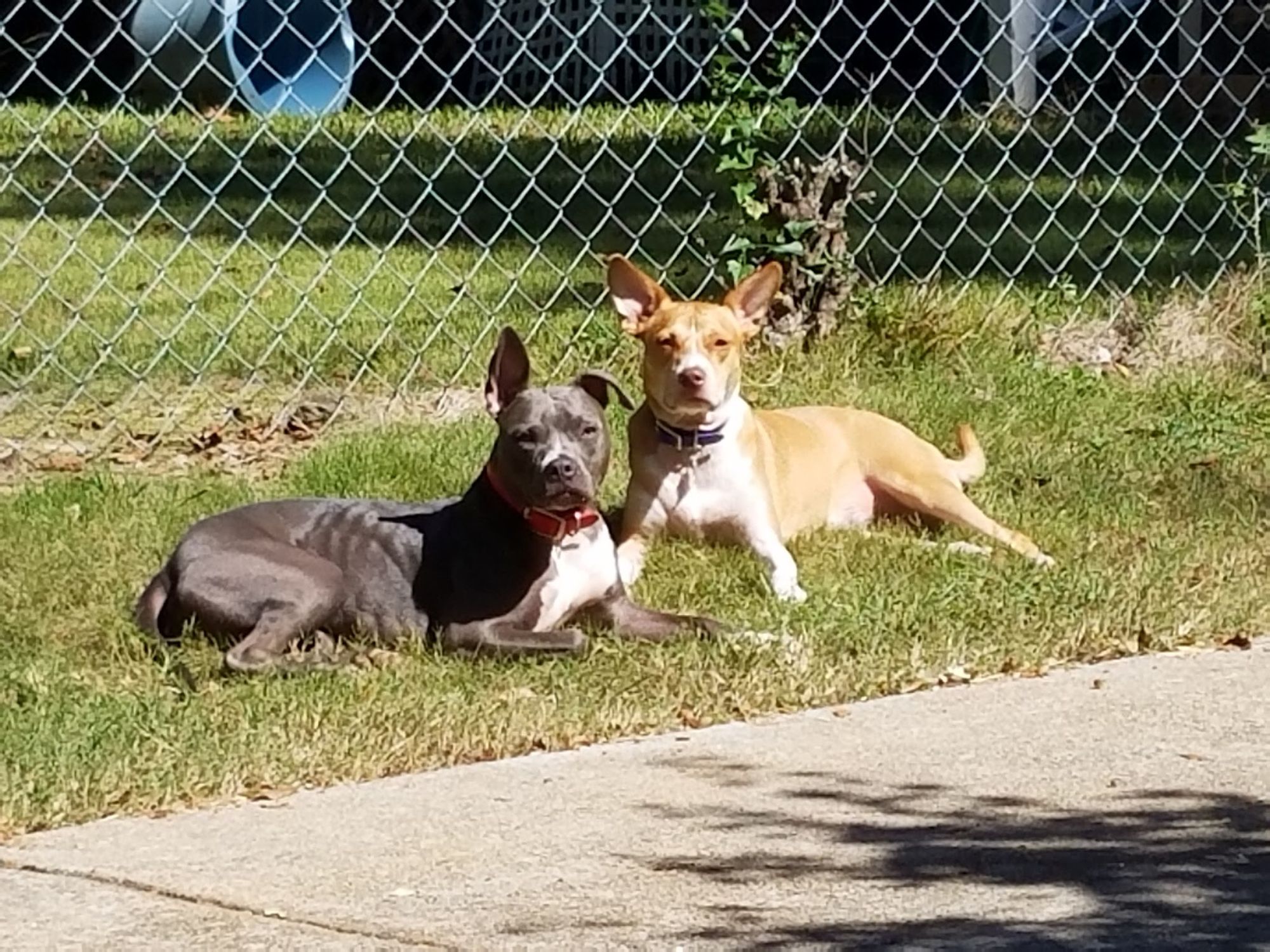

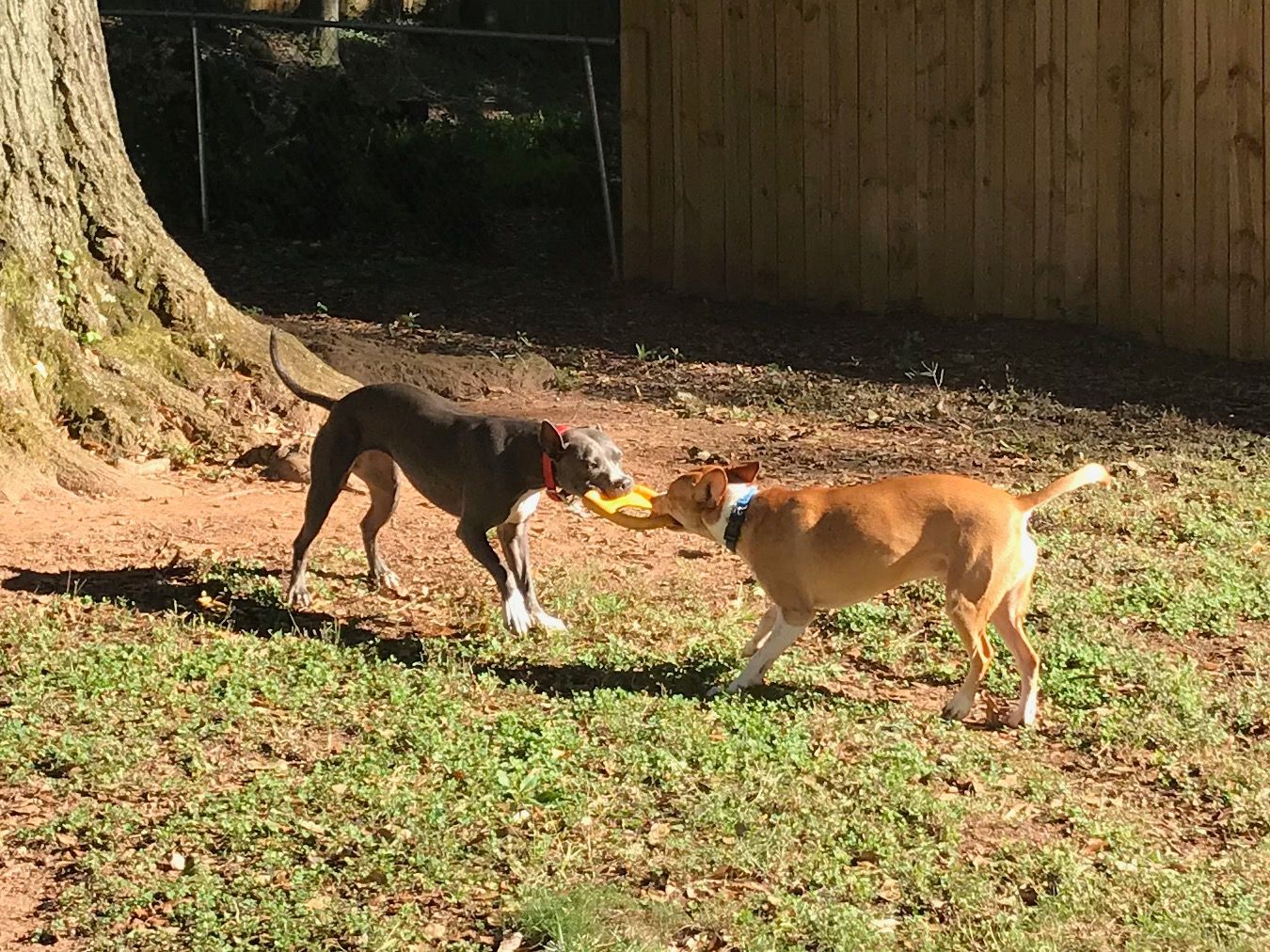
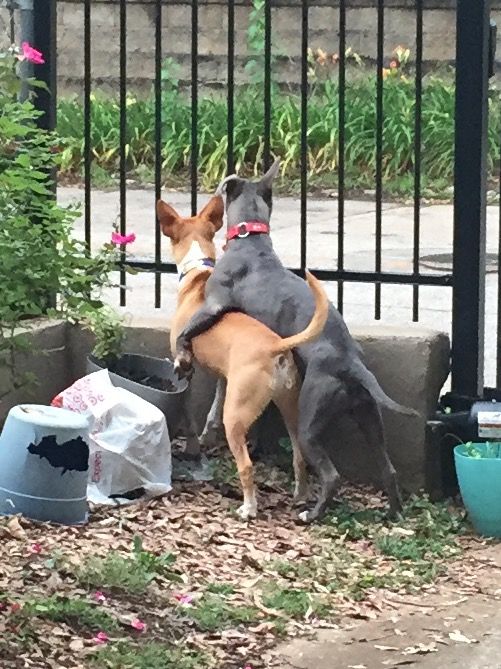
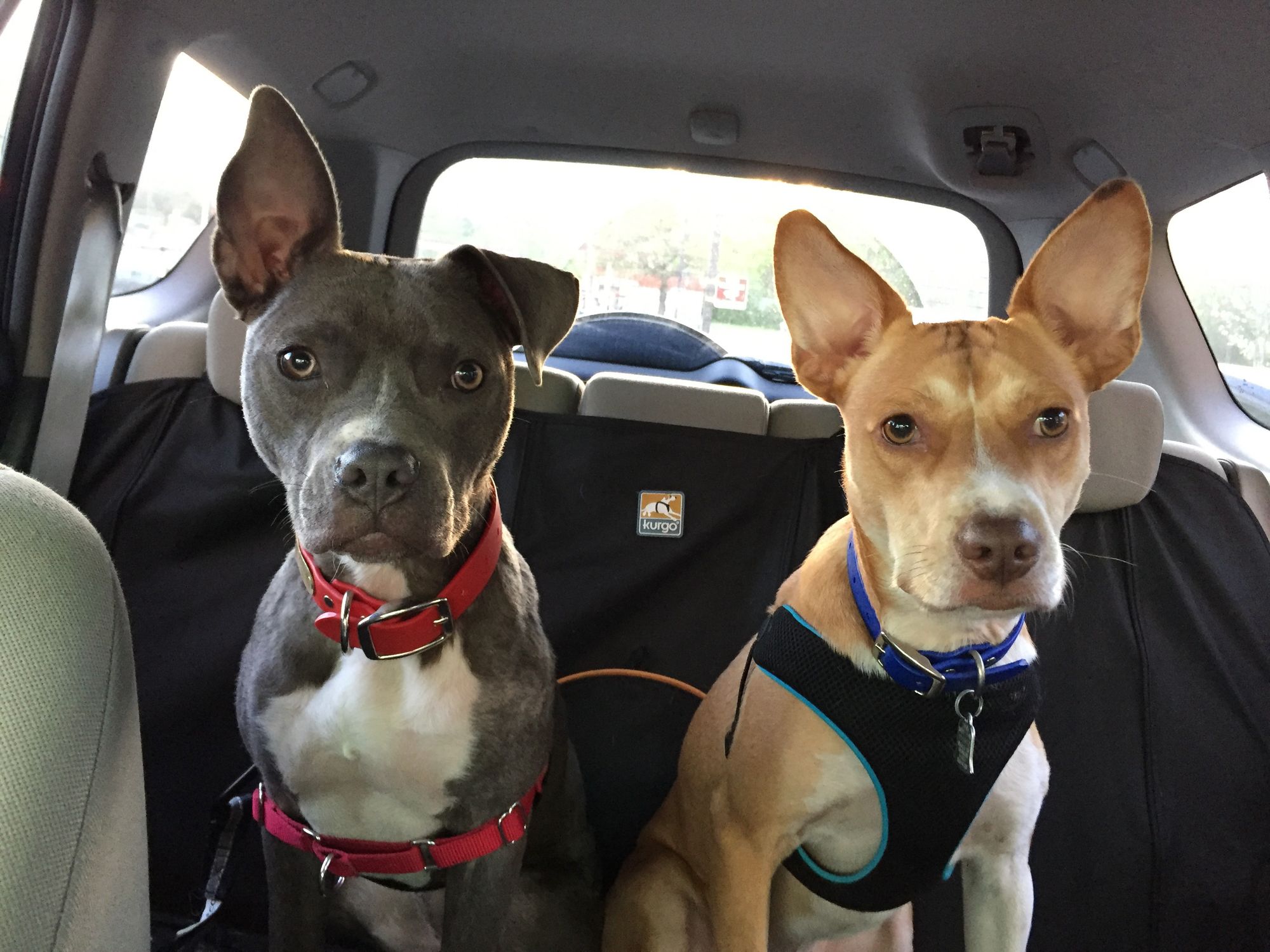
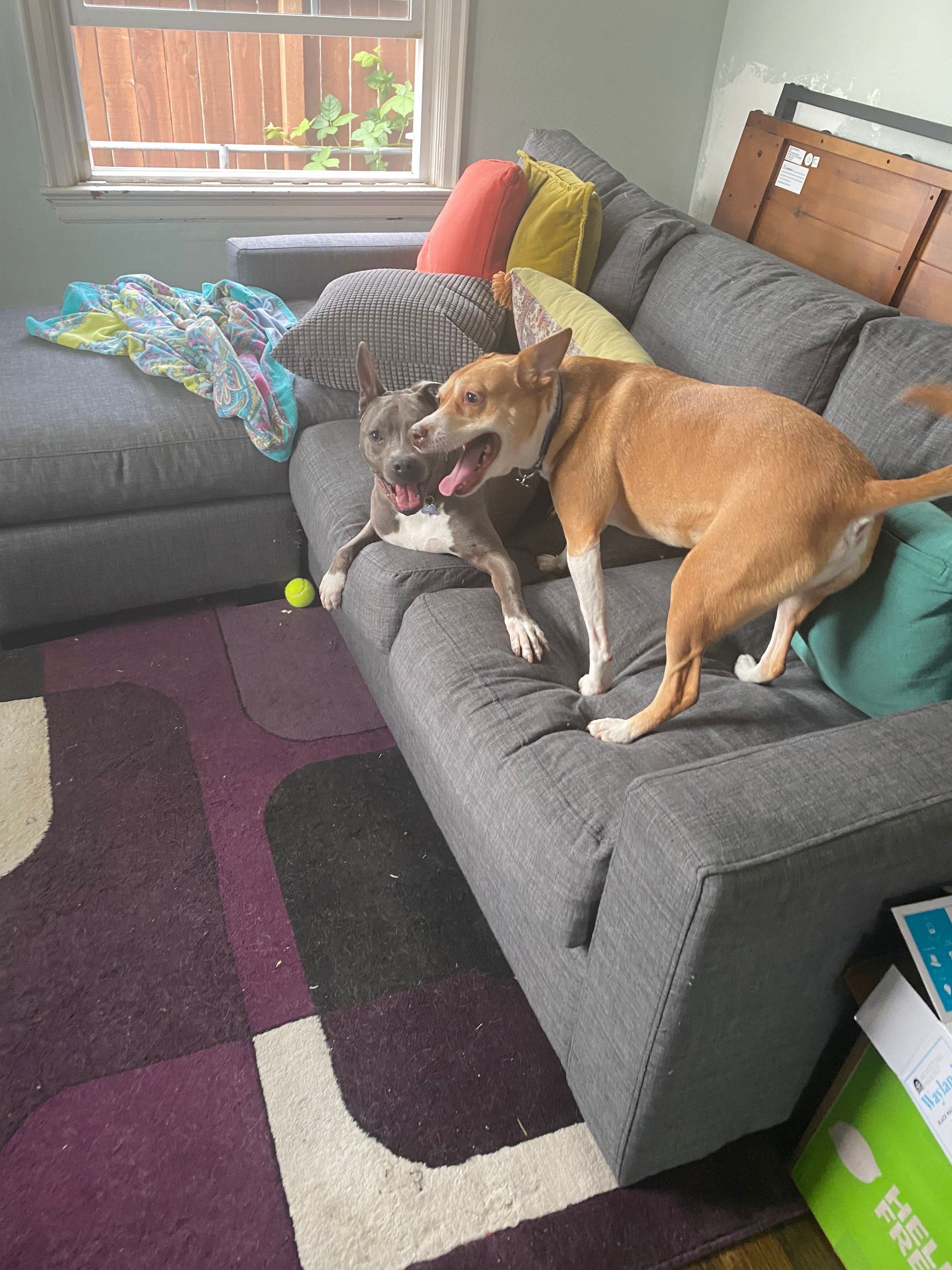
So far you’ve heard about a few of Essie’s behaviors, but there was a lot more to her than her reactivity. Let me introduce you to her more endearing qualities.
Essie Blue loved Winchester more than anything else on the planet. He was the only dog she would tolerate. She adored him and looked to him as the very model for how to be a dog. Because of her outbursts, their relationship was contentious; a big brother and his annoying little sister. But even when she bullied him she was actually begging for his attention. Any offense she committed was quickly apologized for with multiple kisses.
Remember her tiny voice? Winn’s the opposite, booming and guttural. So she tried to imitate him, attempting to vocalize a copy of his deep yawning howl. He’ll never admit it, but he eventually started preemptively barking just so she would take his lead.
She shadowed him on walks. Everything he smelled she stopped for too. In turn he made sure to piss exactly wherever she did, so their territory was always marked together. Maybe that’s why, without fail, she always checked for his penis whenever he came back from somewhere without her. Its scent was clearly essential to both their identities.
Her reactivity triggers did not extend to human beings. She’d get so overly excited to meet other people that she’d strain against her harness and wheeze. I’ll never forget the kid outside Vernon Elementary who asked to pet Essie, then looked at me skeptically when I reassured her my dog wasn’t choking.
Men especially loved to see her, so much so that she’d frequently get cat-called from vehicles passing by. Guys crooned lines like “Hey Beautiful” at her. On one walk Kelly had to stipulate, “You’re talking to her, right?”
She knew she was popular alright and noticed whenever someone adored her. She’d prance around on our walks, trying to draw attention by staring lovingly up at each passer by. Kelly called her the “Mayor of Alberta” for a while because of all the glowing comments they’d receive on their walks up there.
We were lucky that besides Winn we were her favorite humans. Anytime we went for a drive, she and Winn would stand at attention if one of us left the vehicle. When we returned she was over-the-moon, jumping on the center console to lick our faces furiously, as if we’d been missing for months, not minutes.
She loved to dance, so sometimes I’d put music on and do a little shimmy or play air guitar for her. She’d bound up to me, prancing her feet around. Sometimes she even jumped up to join me on two feet and I’d hold her front paws in my hands. This kind of jumping was technically prohibited, but she had such a big smile I couldn’t bring myself to reprimand her for it. She showed the same level of excitement whenever we came home, especially if I’d been at work all day.
“She’s aggressively happy,” Kelly would explain to people.
A sign of her happiness was the way she’d march around when she got excited, lifting her paws up high one at a time before slamming them down. Kelly describes her like a derby girl who’d barrel into anything and everything. We both have the scars and bruises to prove it. She never bit anyone other than us, but people could get a little freaked out by her excitement because she’d mouth at their hands so frantically. Even one of our trainers thought Essie tried to bite her, when all she wanted was to say hello.
I’m thankful for drive-thrus, which allowed her to interact with people without coming at them like a rocket. Whenever we pulled into one she’d sit up straight and pretty in the backseat, head held up high so they could see how well-behaved she was. She liked to see the people there as much as she liked the biscuits or pupachinnos they gave her. Those drive-thrus were probably where she learned how to nudge us to get our attention. All of a sudden a cold nose would press forcefully against your skin, demanding consideration.
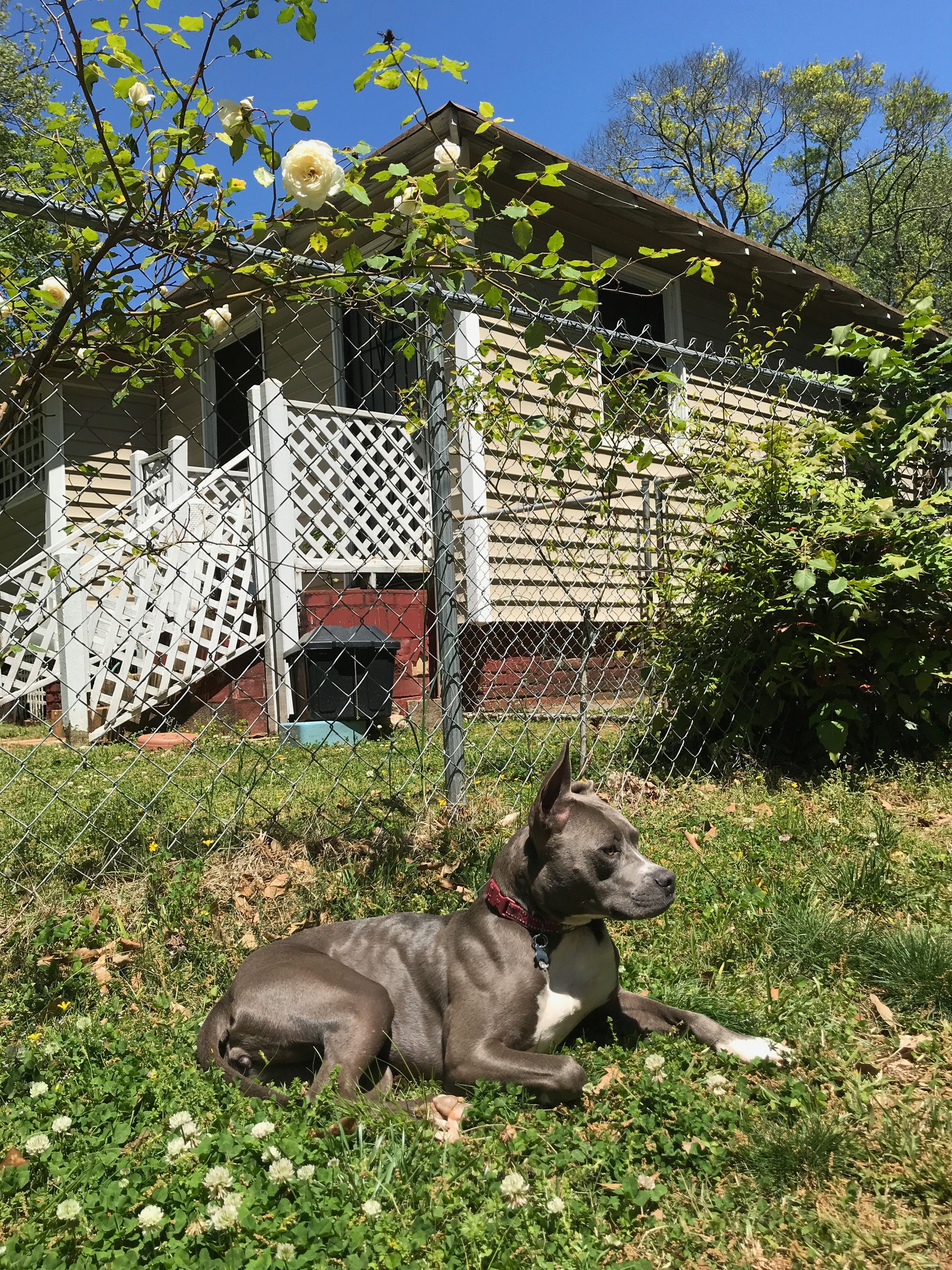
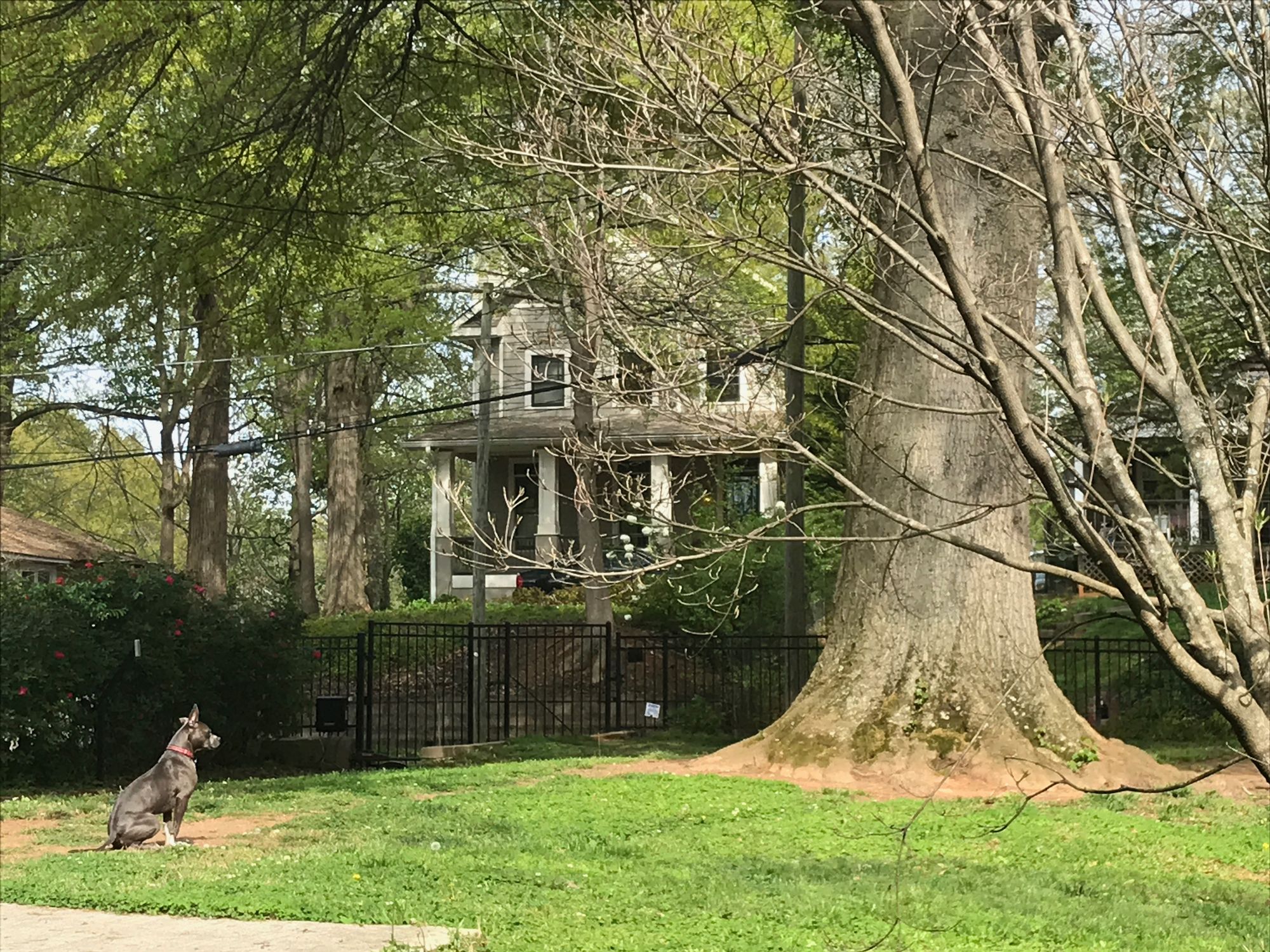


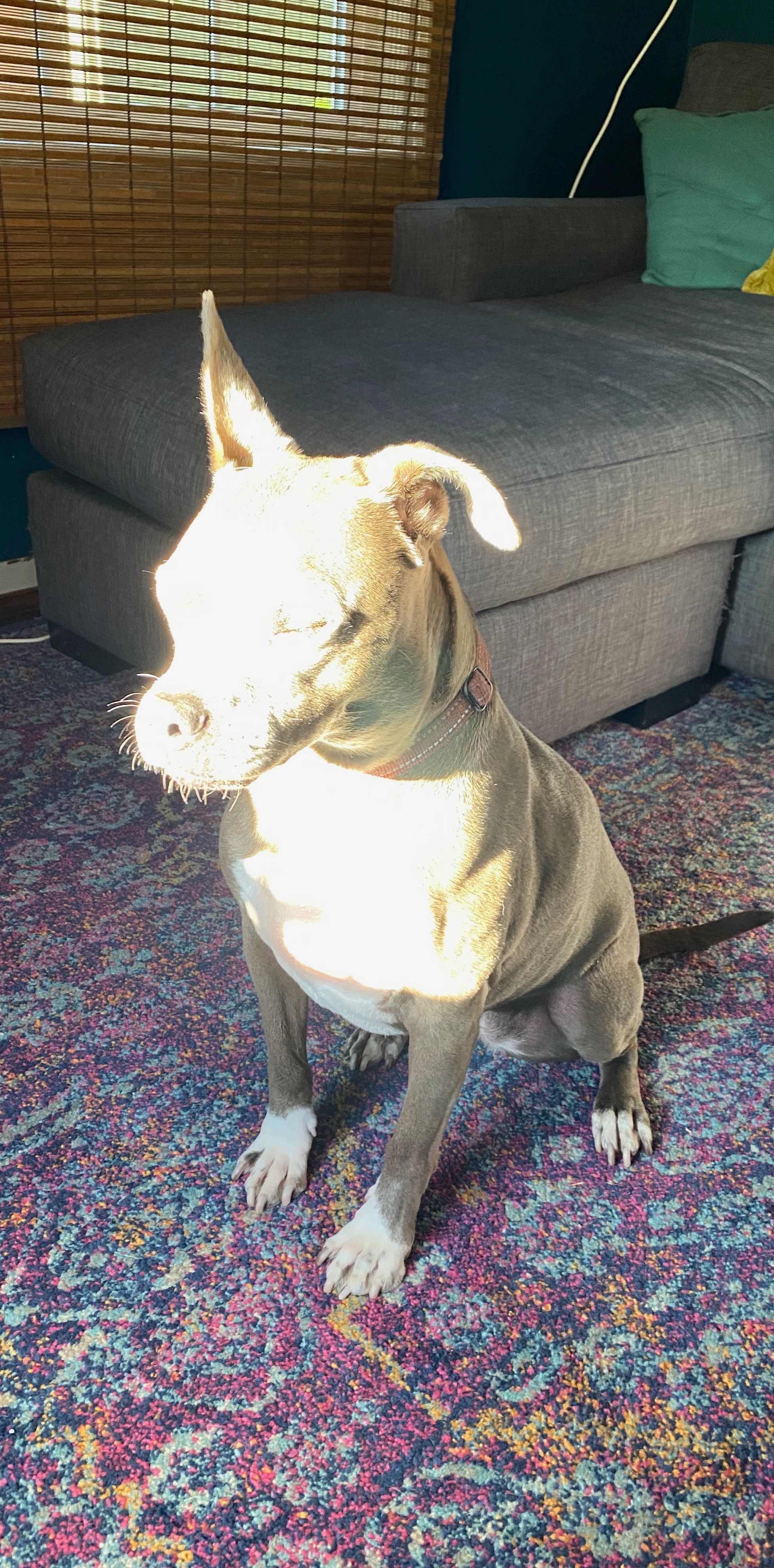
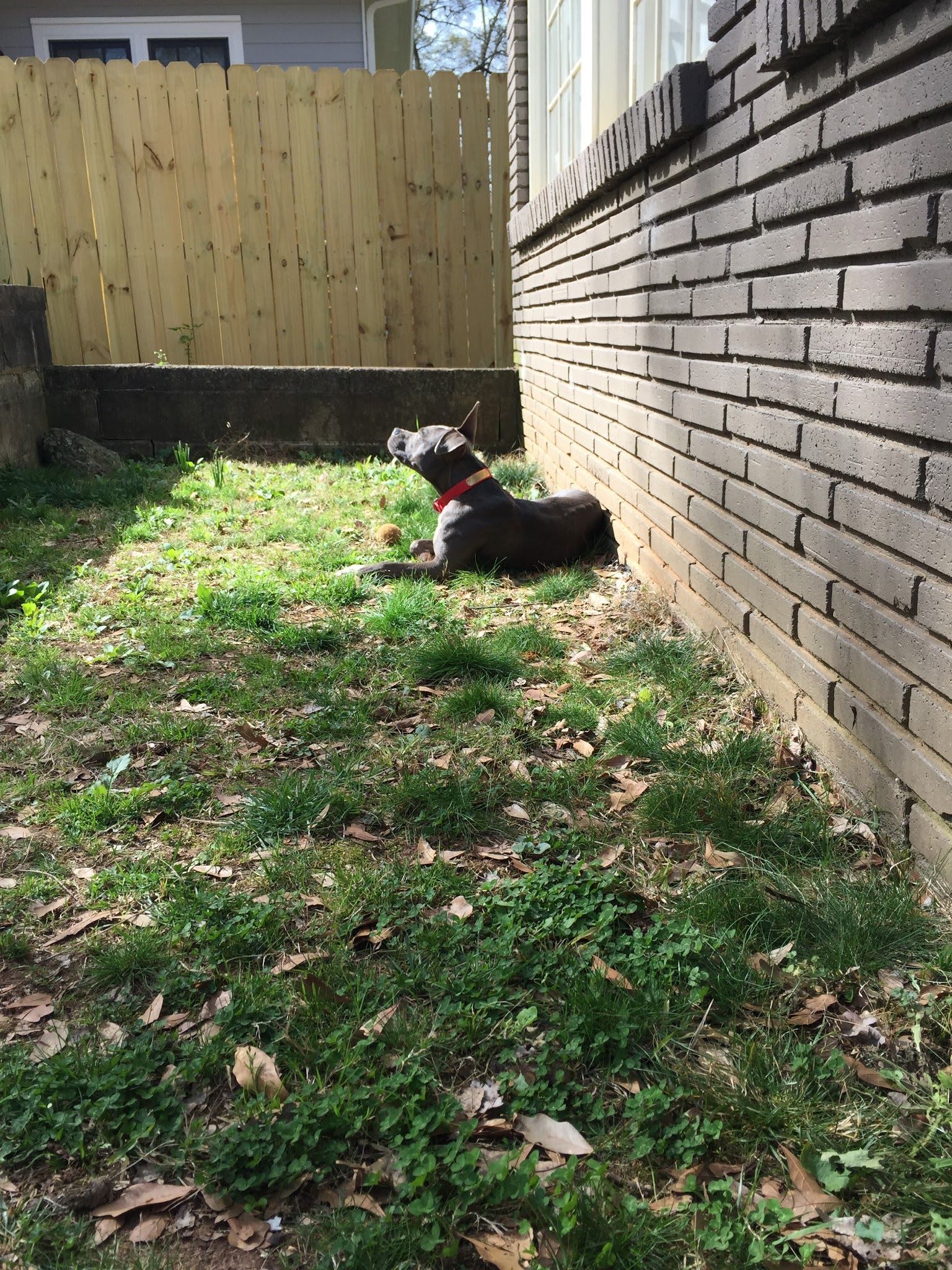


That nose was the only thing cold about her though. Essie probably burned so bright because she was solar-powered, always basking in the sun whenever she could follow its beams around the house. During her last few days alive she went outside with both Kelly and Winn and just sat calmly in the sun, soaking it up and watching them in the garden. The day after she died the sun shined bright, unusual for Portland this time of year. It beamed down and through the house, making us think of her. So we drove back to where it all began, that Subway parking lot at Cascade Station, and took Winn for a walk through the autumn leaves and the warm daylight. We reminisced about her, talked through our grief, cried and had a few laughs.
That sun shone even brighter around noon on the first day after her death that I started working again. During my lunch break Winn and I laid on the couch together, letting the sunbeams blast us with heat. I held the toy that she rested her head upon when she passed away and it felt like she was there, laying together with us again.
If her little furnace was solar-powered it would also explain why the second dusk approached she’d call it a day, heading into the bedroom or tucking herself into a nest of blankets in the living room. To do this she’d relax into a prone position and let out a loud, heavy sigh of comfort. This evening routine was so consistent we had a phrase for it, “Sun’s down, Essie’s down.” It was fitting that her euthanasia process began just as dusk fell over the west coast.
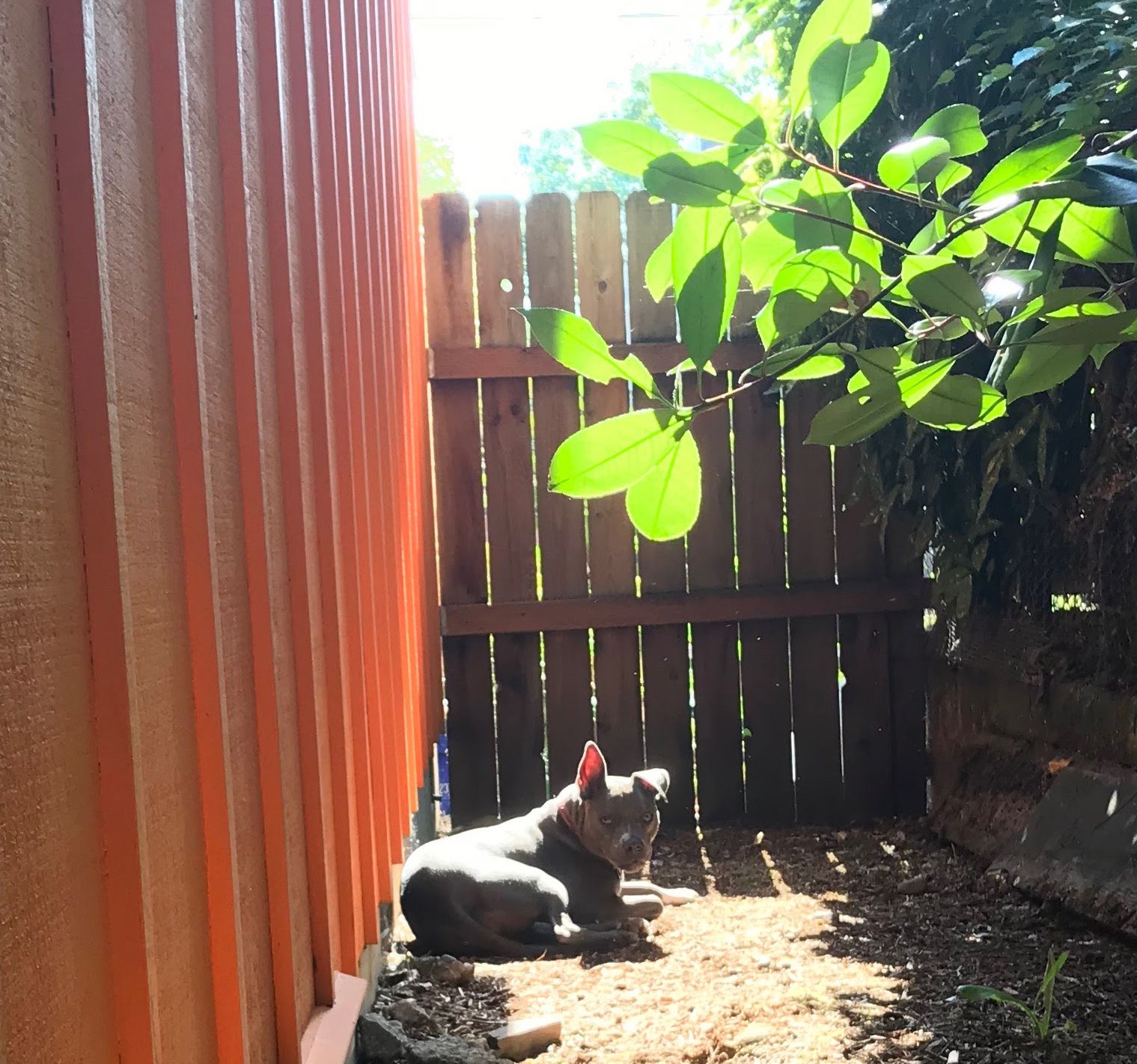



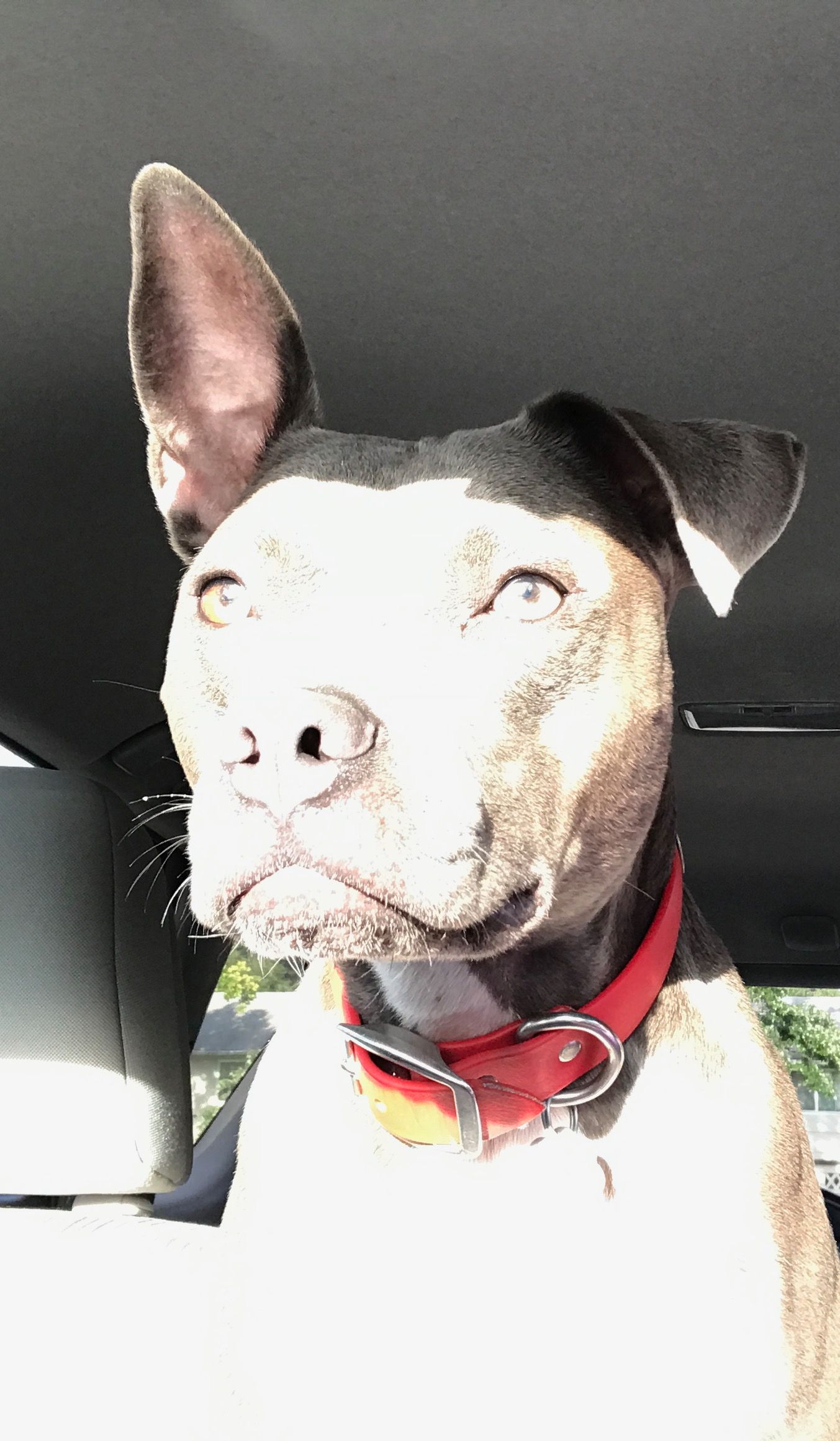
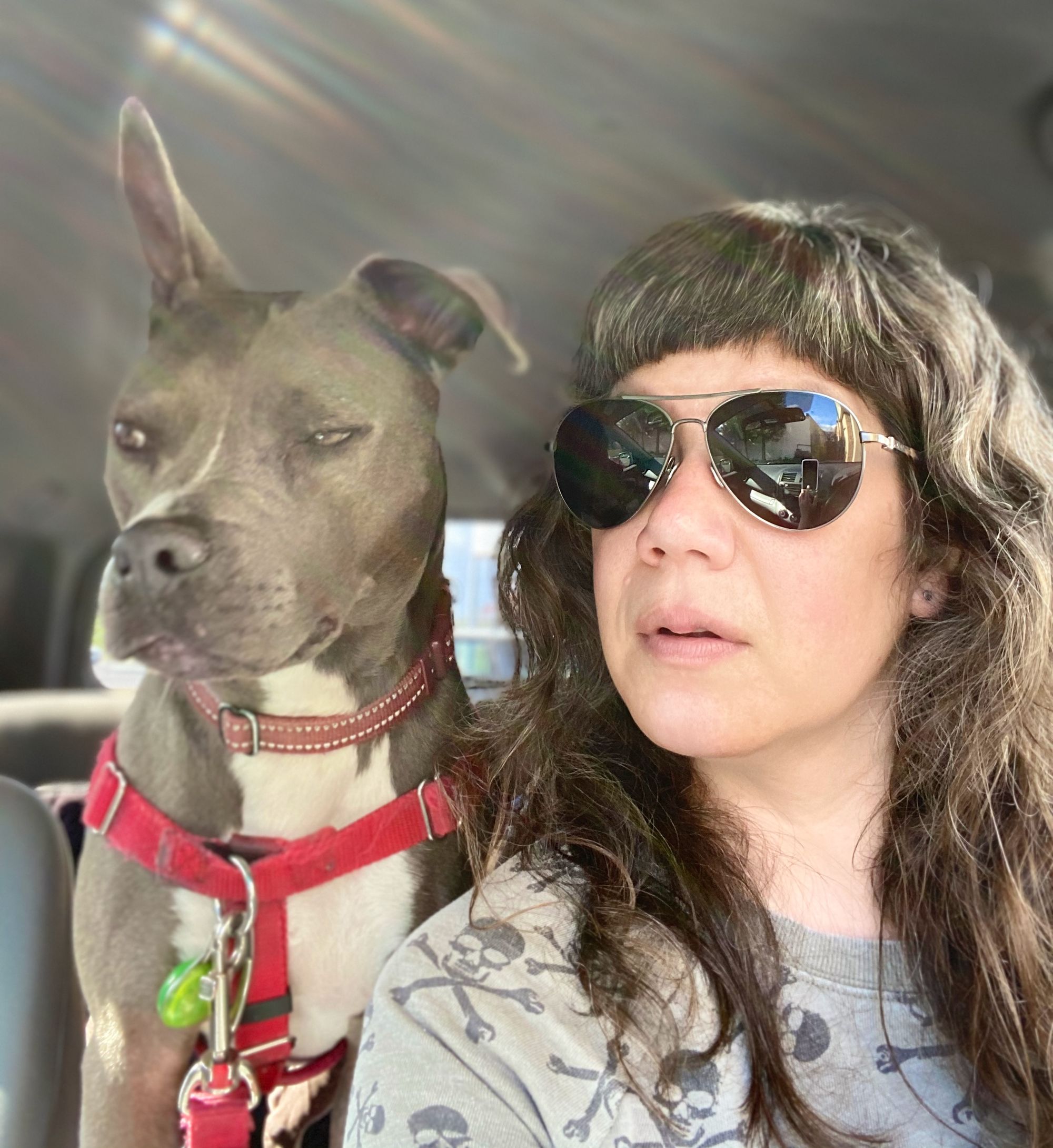
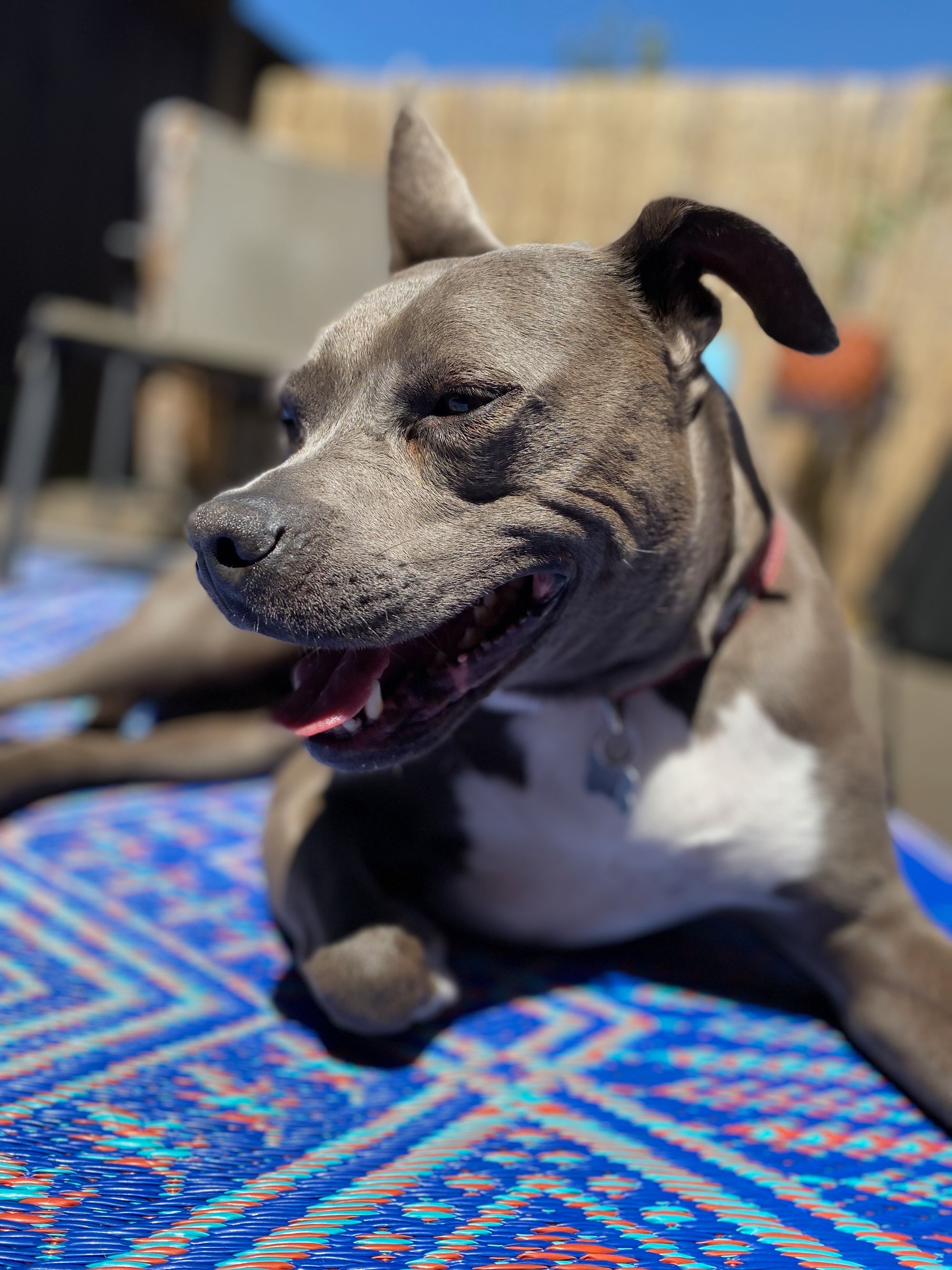
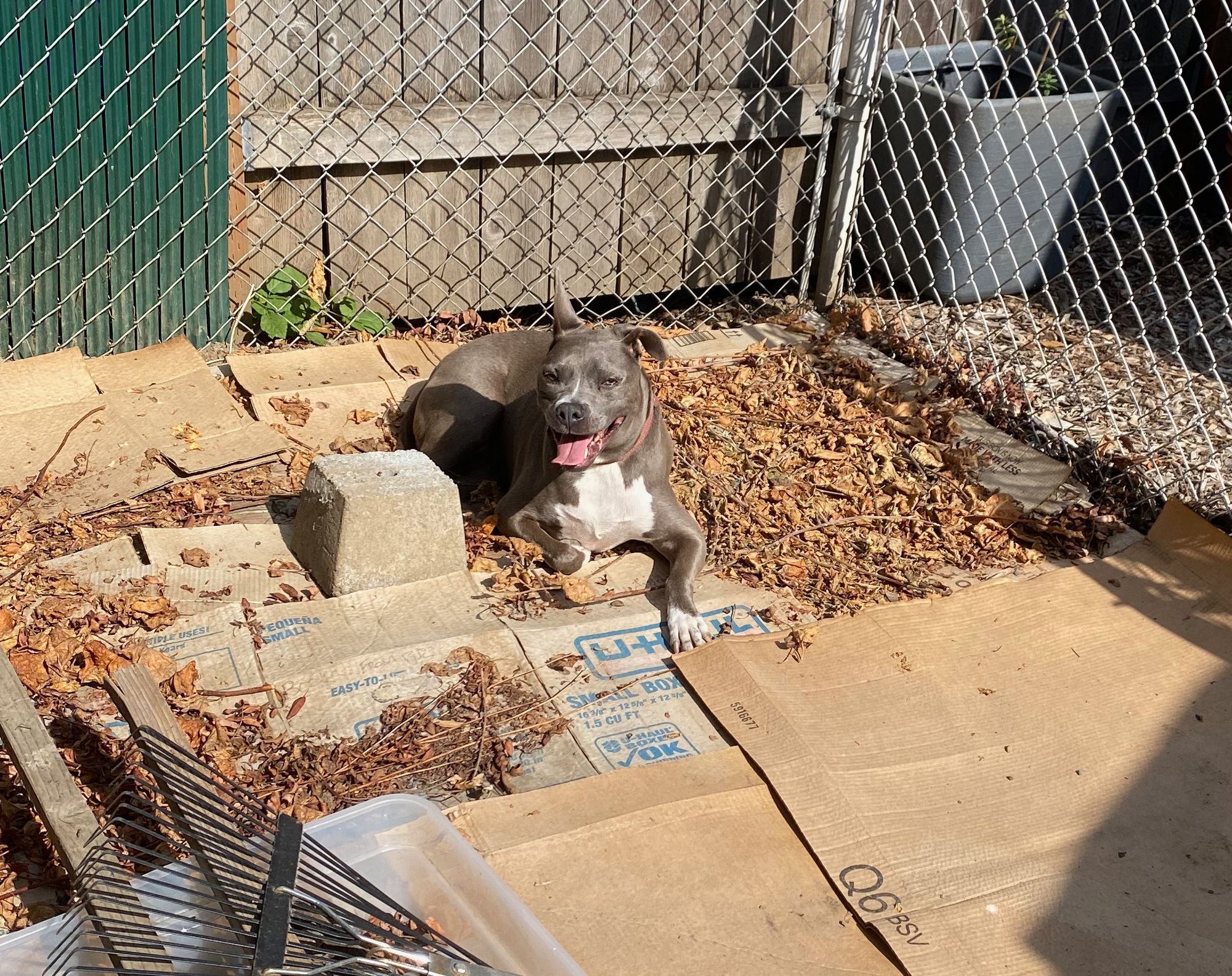

And once Essie was down, she was down. She was a power sleeper. For only fifty pounds of body she used every inch of it to take up our king-sized bed. In fact, it was probably more her bed than ours, given how much time and space she spent in it. She’d barely move an inch all night, completely dead weight, even if you tried to move her aside to fit.
Whenever she settled in she made sure at least one part of her was touching us, maybe a paw or a chin. Sometimes she’d purposefully lay on top of us like a pile of bricks. This could get so hot I’d flee to sleep on the couch. But I didn’t care, as long as she was comfortable. On one of her last nights with us, we went out on the couch together and she curled up in a nest of pillows at my feet all night.
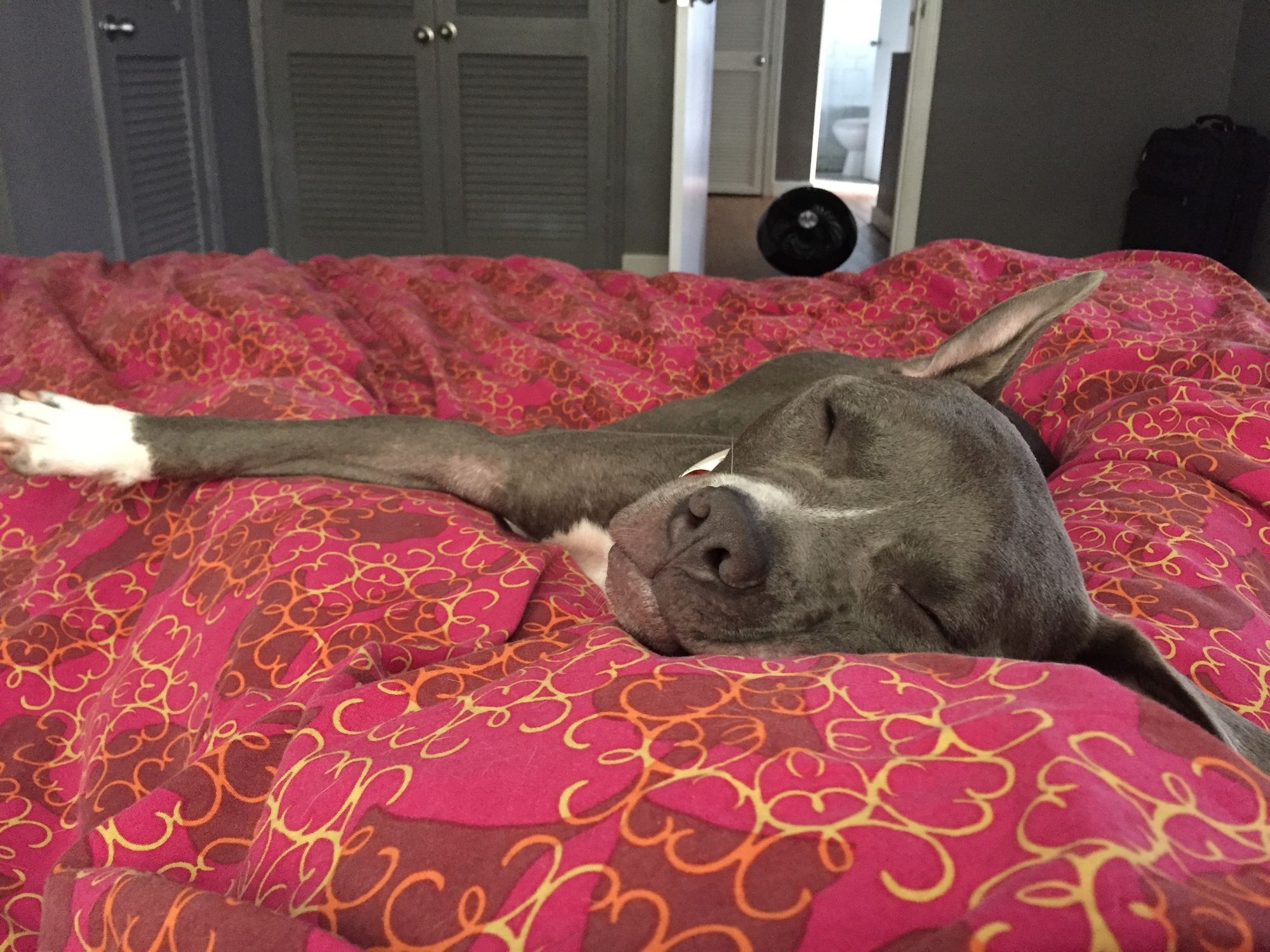


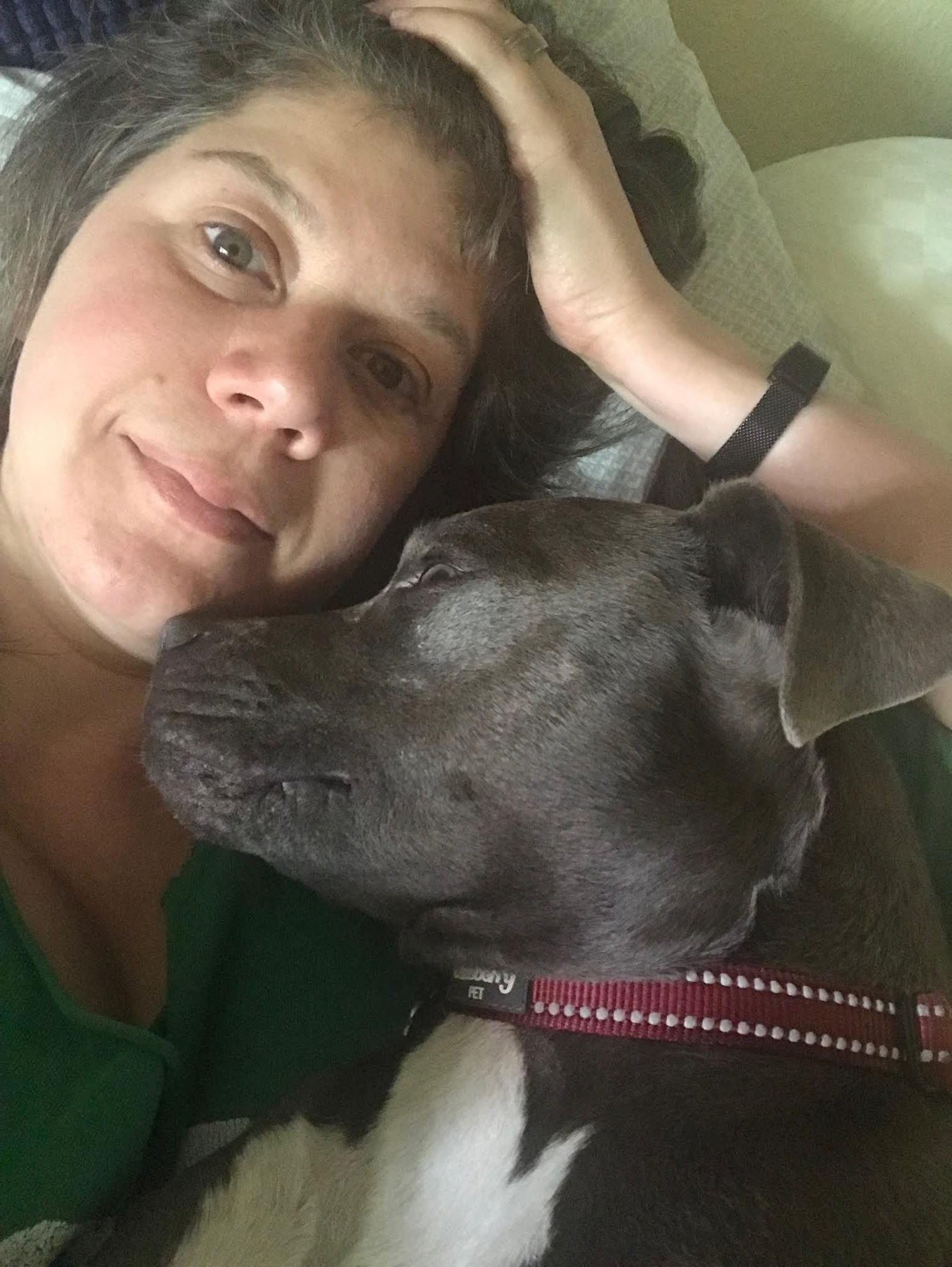

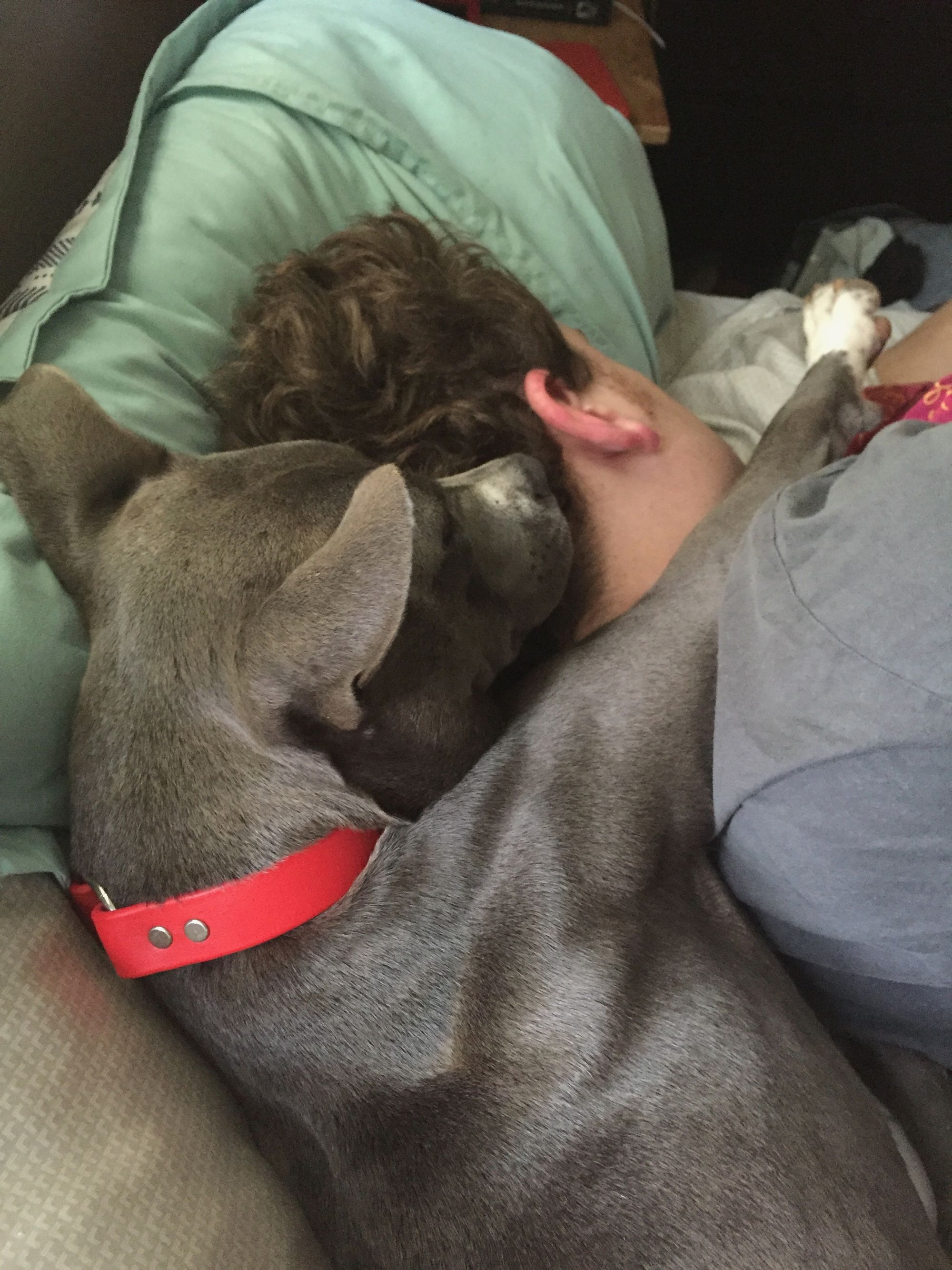


Some mornings we’d wake up and realize our sheets were messed up and unaligned. We’d blame this on the dogs, but Essie took it a step further when she’d get zoomies indoors. She’d spin drift so fast on the bed that she’d unmake the entire thing. Not a few minutes later she’d collapse between the piles, blending in so seamlessly we’d be surprised to find her there.
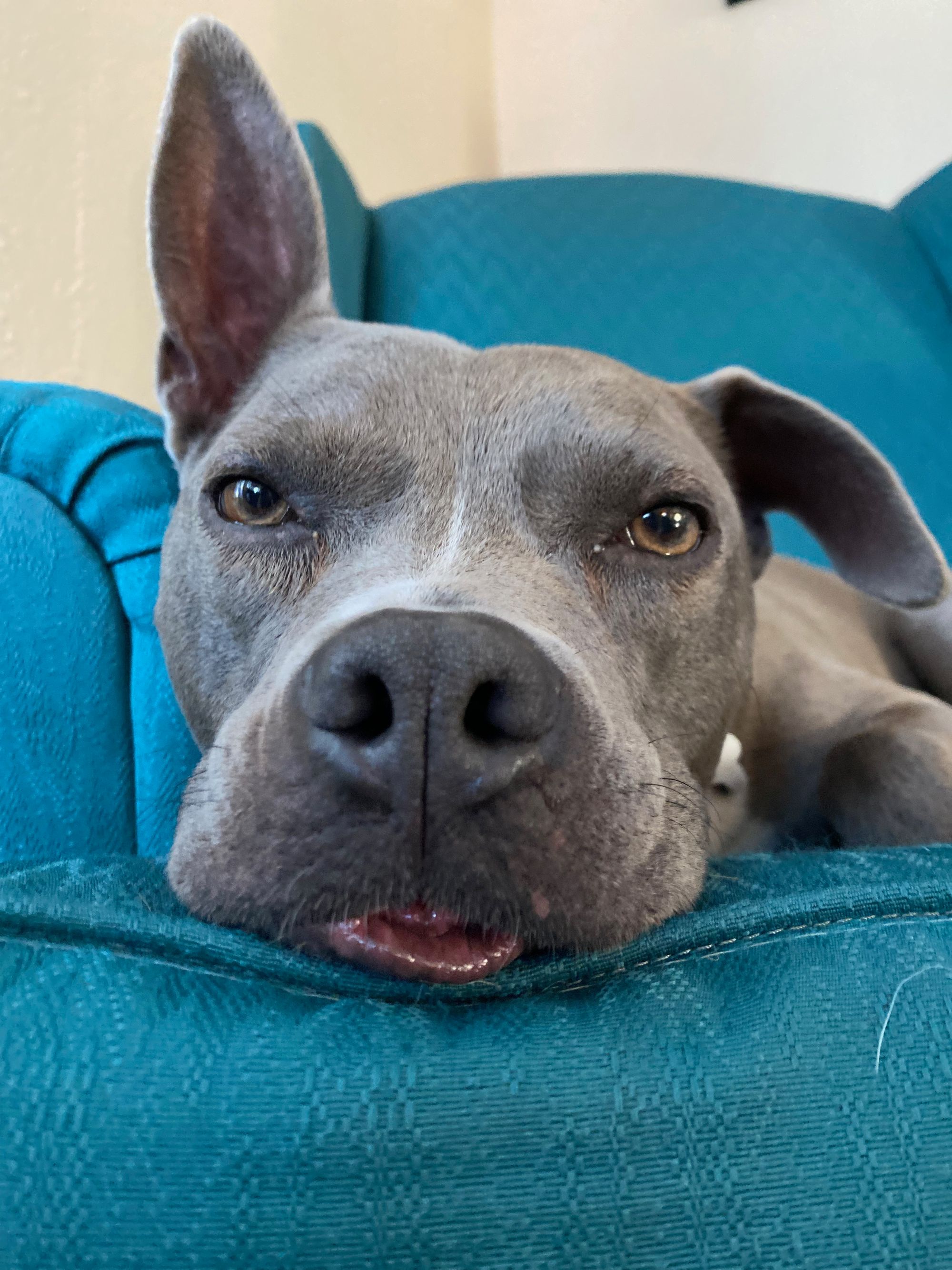
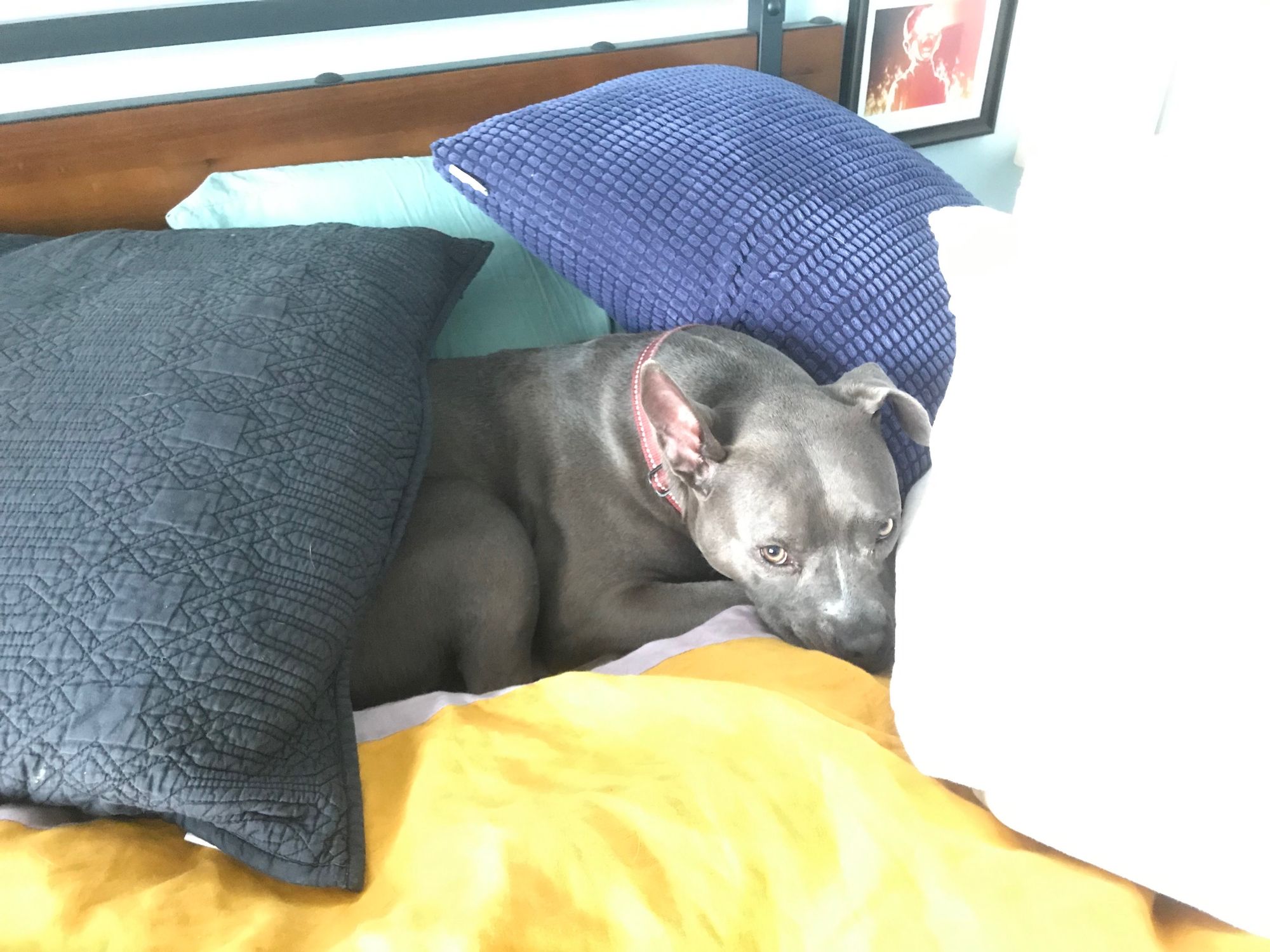
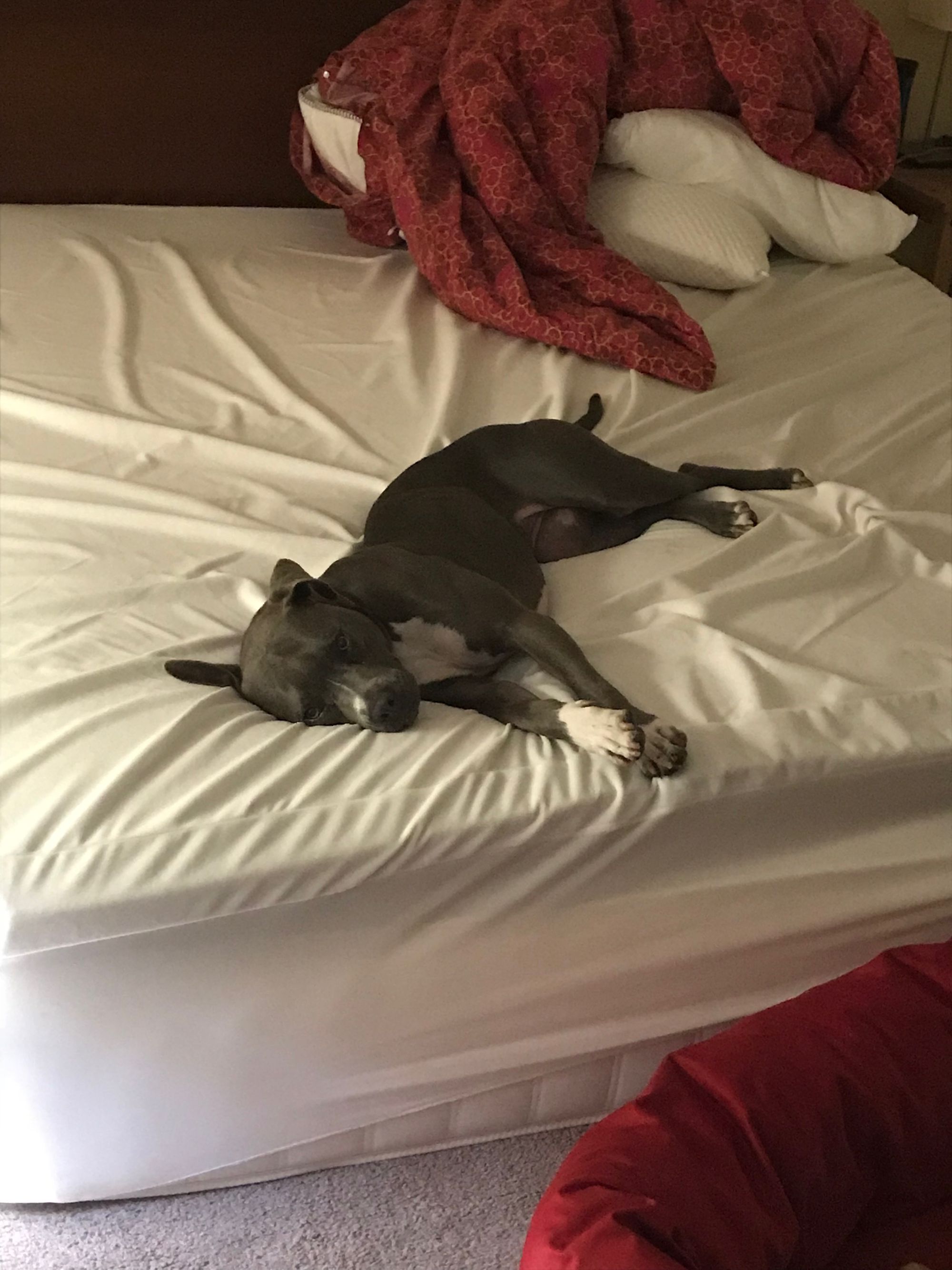
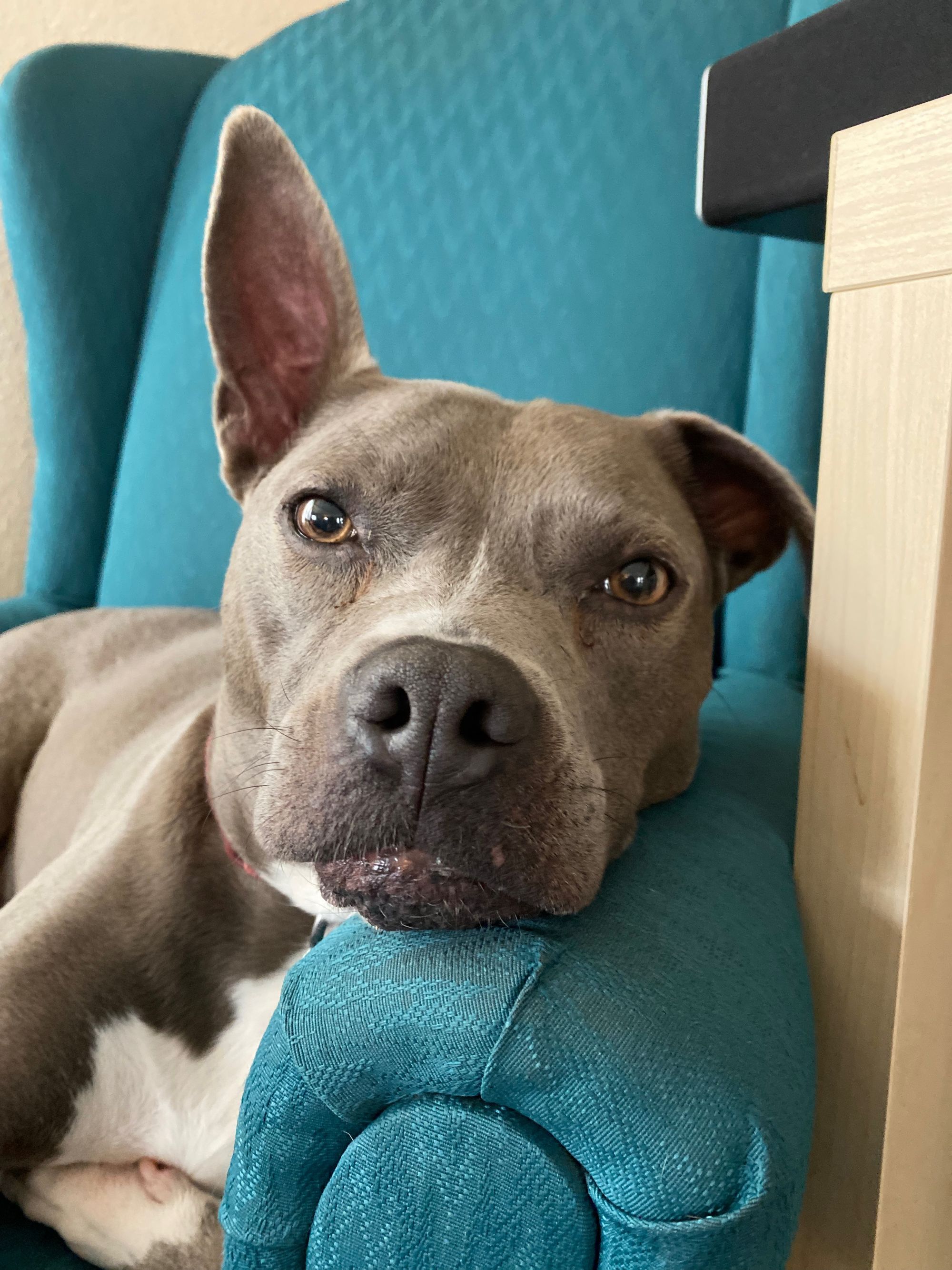
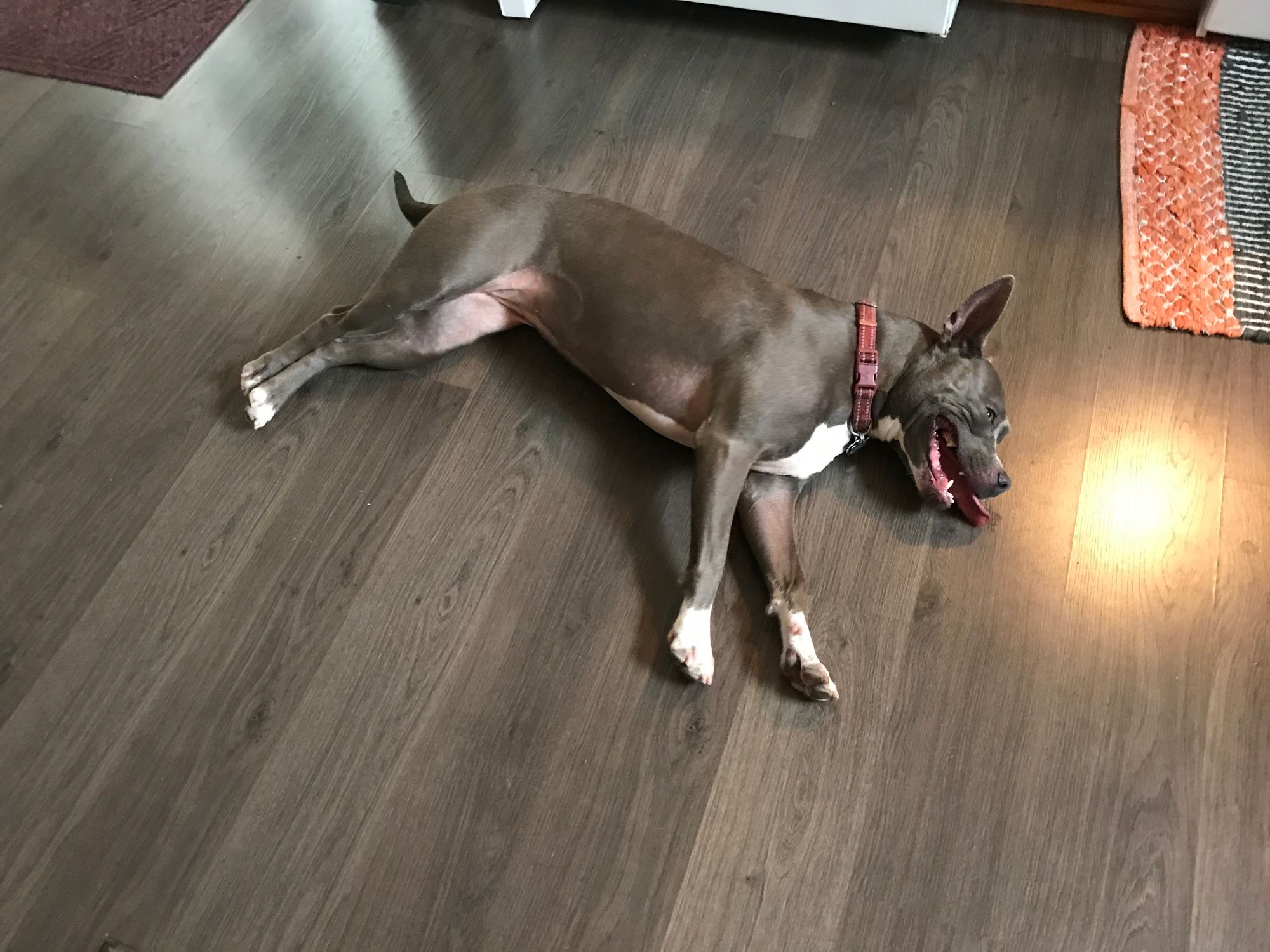

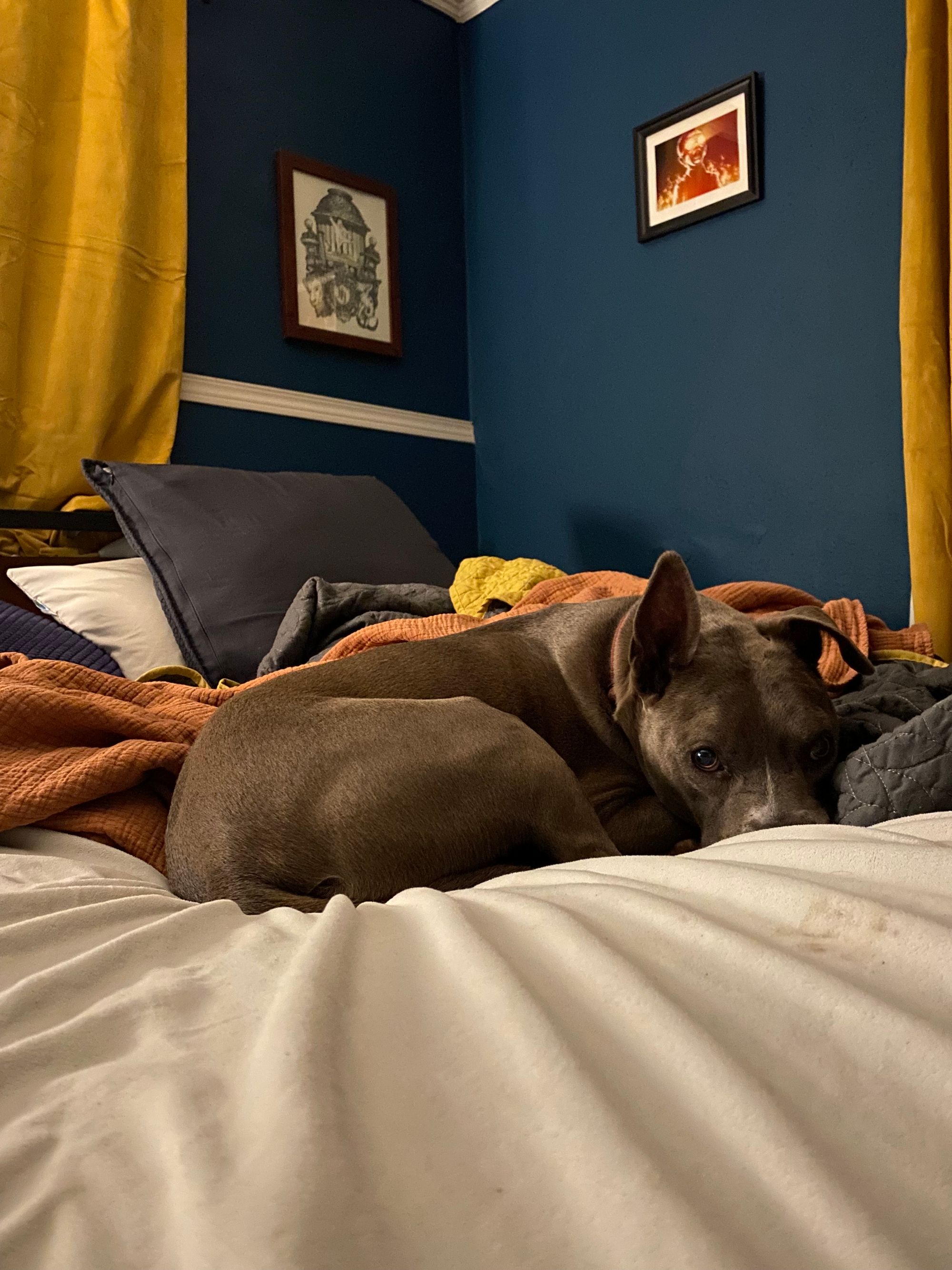
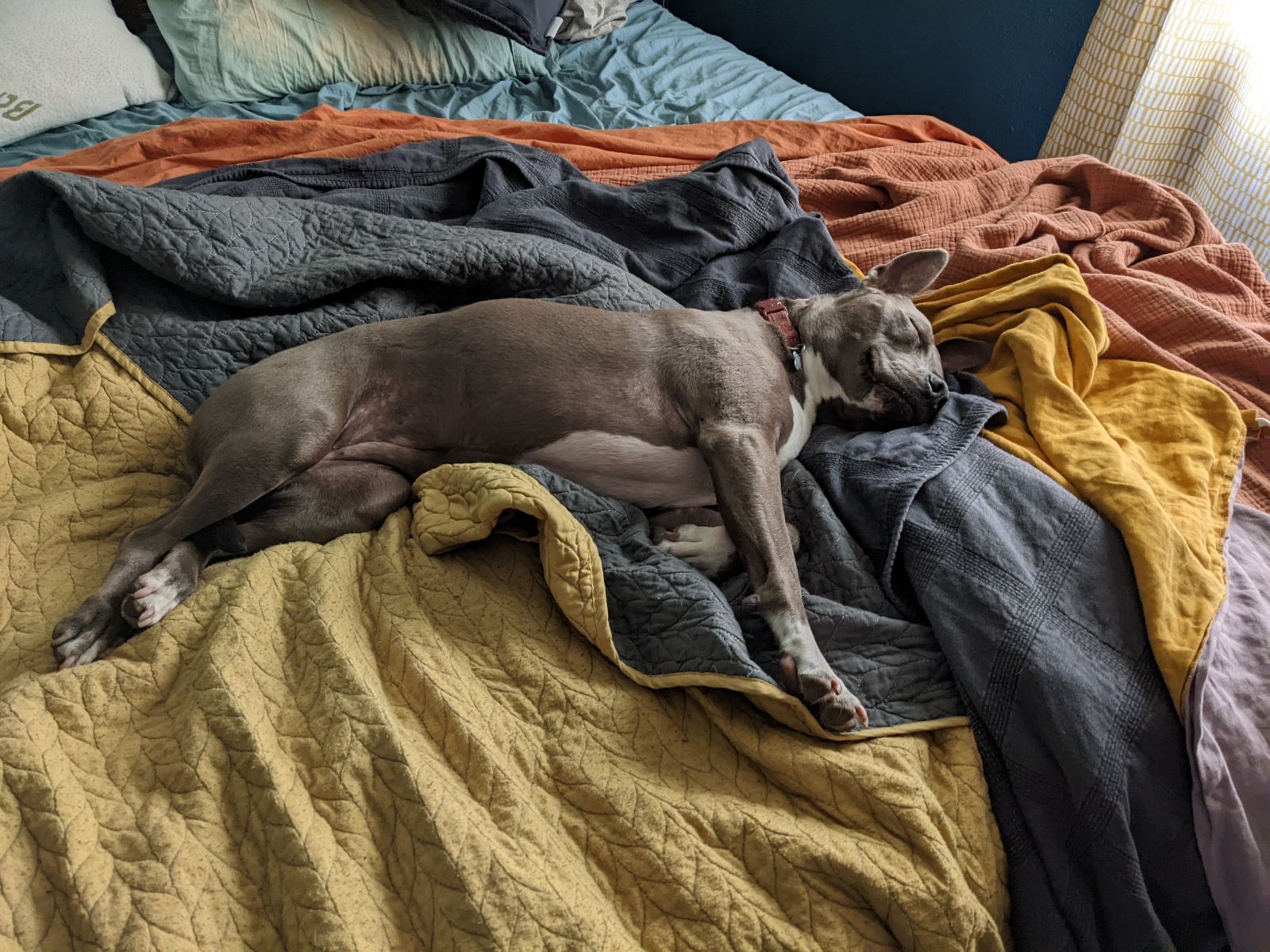
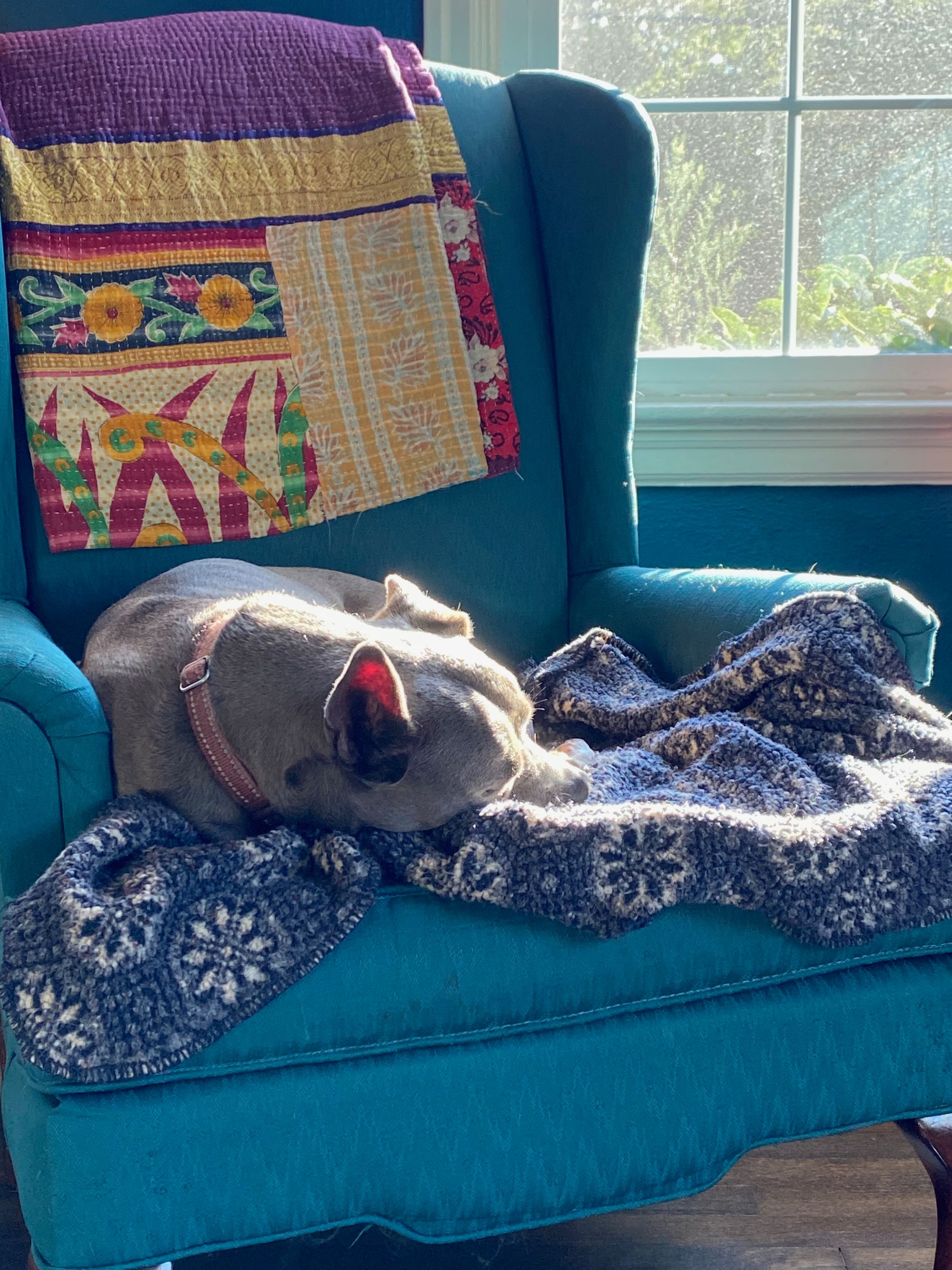
For a dog who was found out in the cold on Atlanta’s streets, Essie Blue had a big life with us, far beyond that cement block she was tied down to for the first year of her life. She ran on the beaches of both the Atlantic and Pacific oceans, went up mountains, through forests and danced in the winter snow. She crossed the entire country with us, Winchester and our two cats. At seven years old, she was too young to die. We wanted her to grow old with us, slow down, gain weight and change with every season.



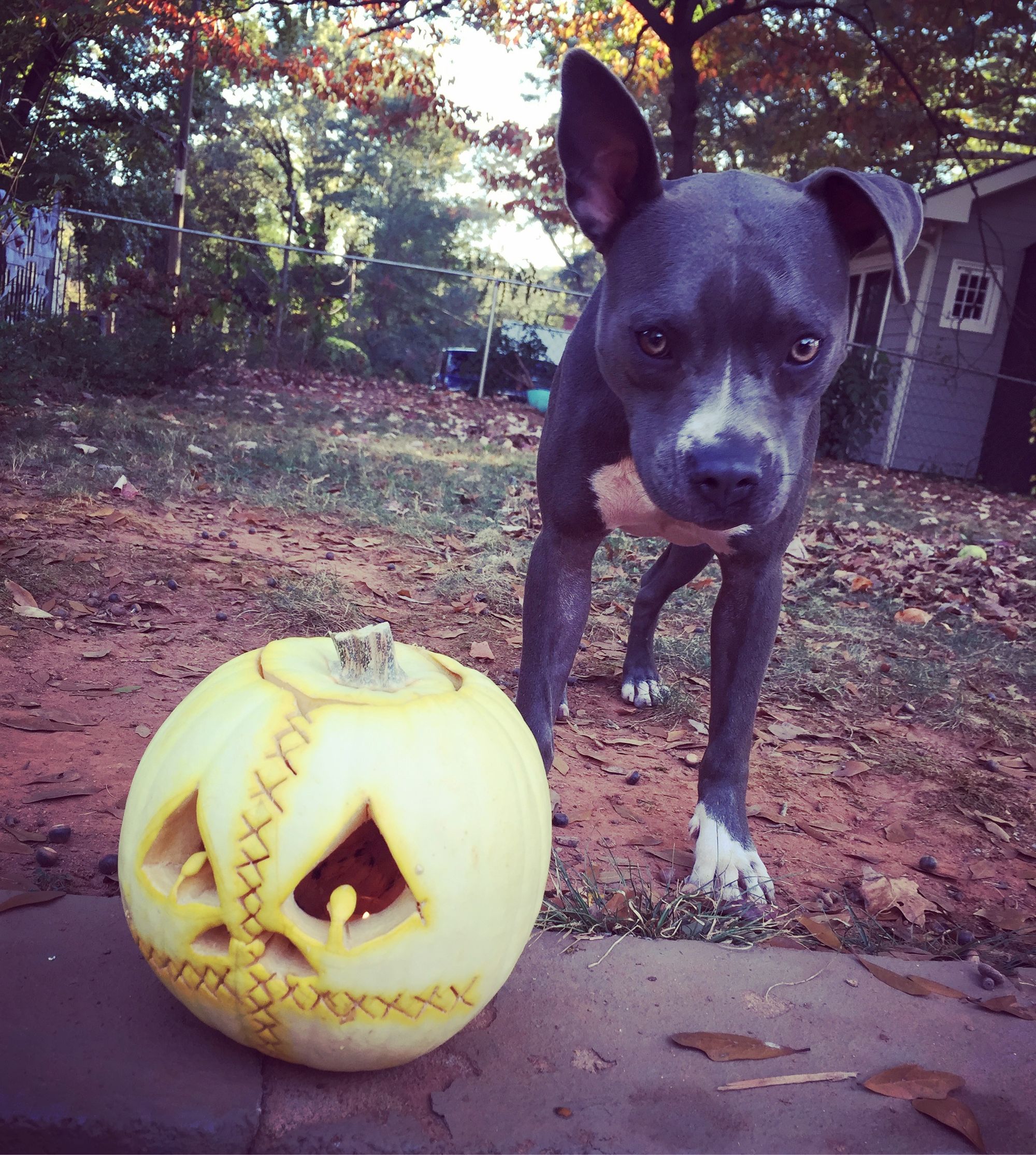
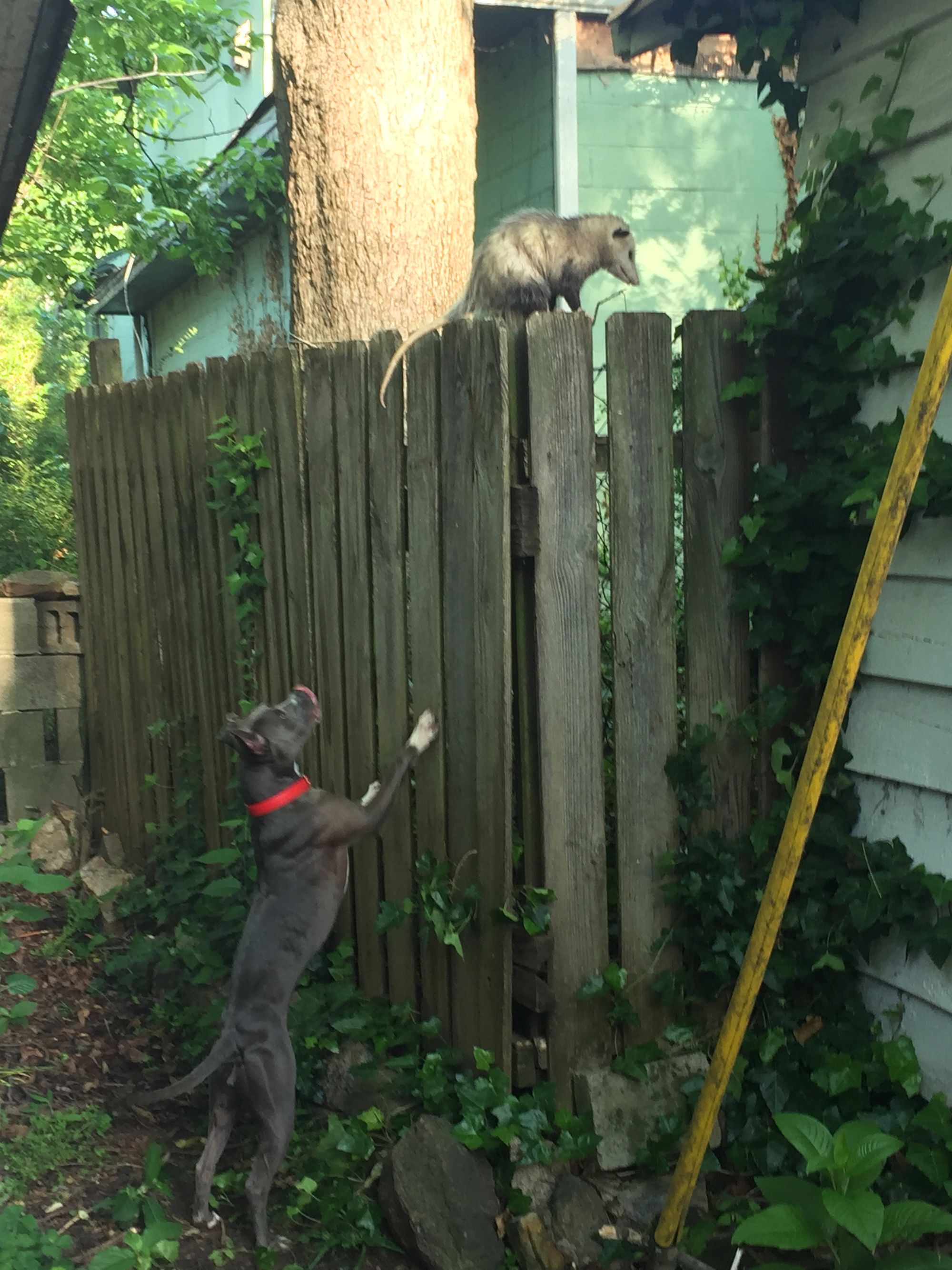

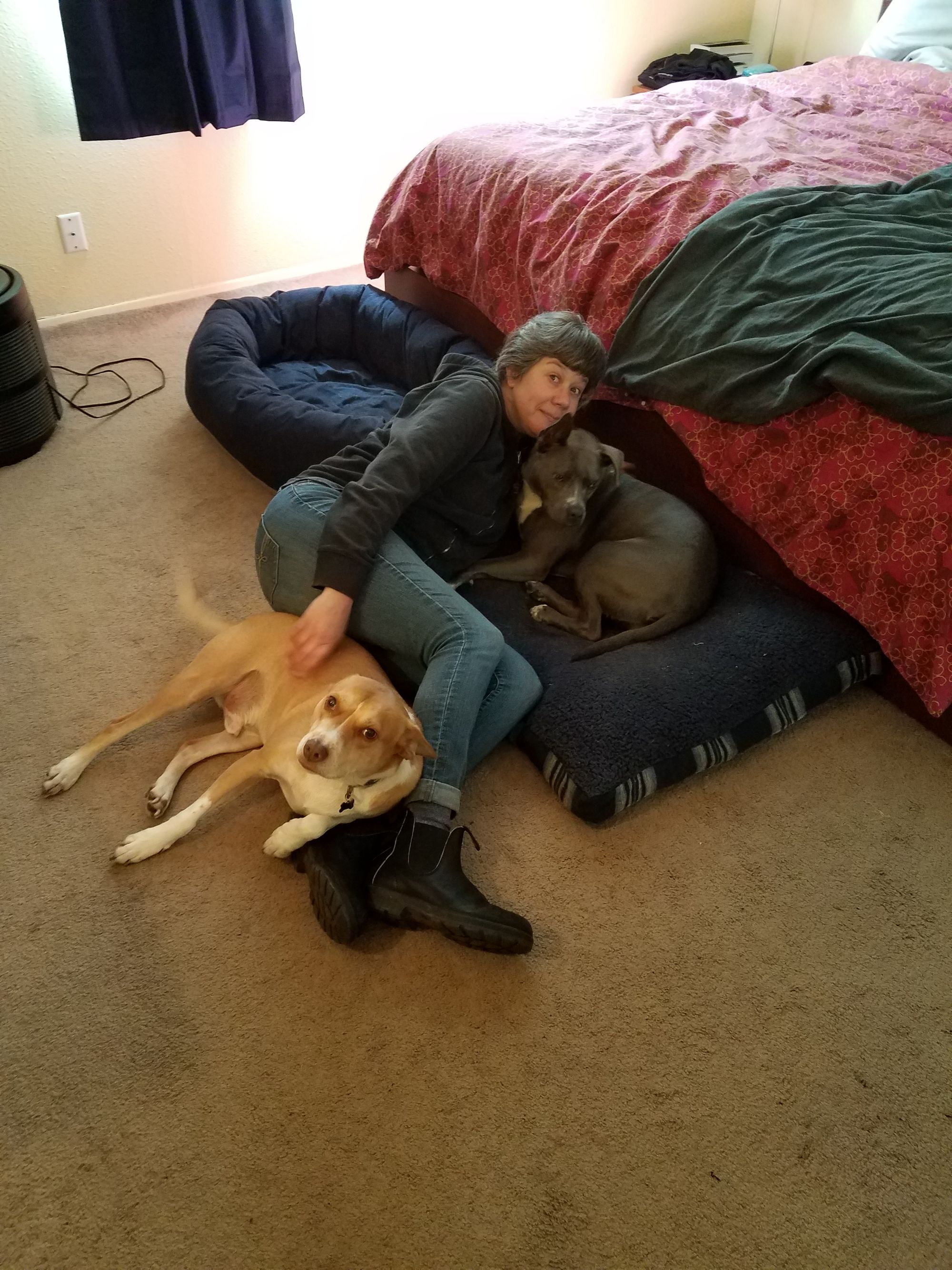
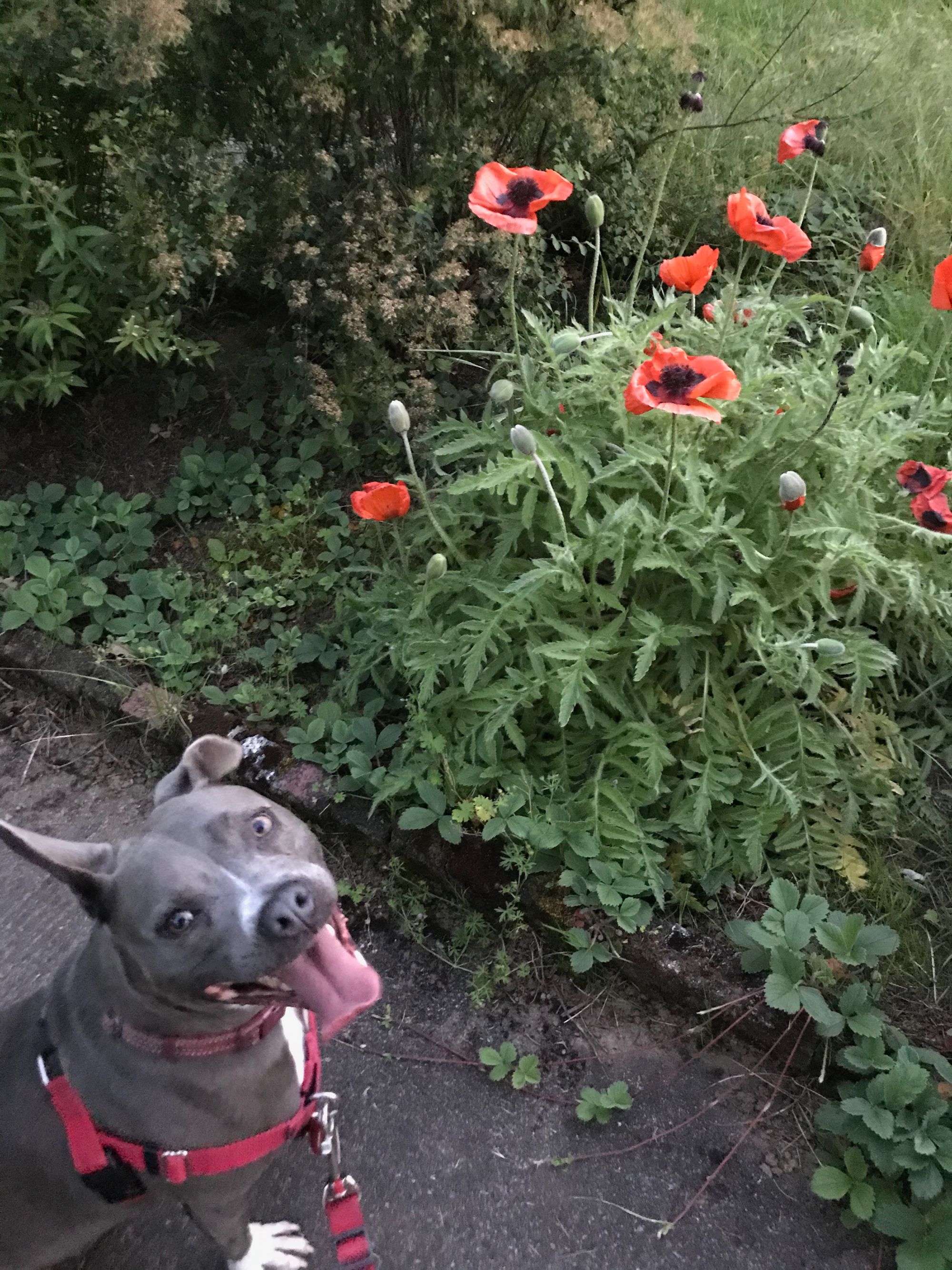

I’ll forever remember that she mustered tail wags for both of us when we visited her at the hospital toward the end. We even got them in the hospice room, minutes before she left us. On her best days you had to watch out for the “whap whap” of that incessant tail, lest you get it smack in the eye.
I’ve long since lost track of wherever the hell I’m supposed to be on the Kübler-Ross stages of grief, but for the first couple of days I could physically feel a wound where my heart is, like it was split in half. There was a bottomless ache in my stomach and my extremities were cold to touch. I’ve managed not to cry in the shower for several days straight, but everytime I think I’m past the worst of it I’ll burst uncontrollably into tears.
I’ve known some people who avoid commitments in their life — pets for example — because they don’t want to feel that inevitable pain of loss. But to quote Star Trek: The Final Frontier (yeah, that’s where I’m at), “I don’t want my pain taken away. I need my pain.” I don’t want to forget Essie and tuck my heart-wrenching memories of her away in some box in a mental closet. I want to remember every inch of her and how much of life we lived together. She gave 110% to everything she did and always hoped we would do the same.
There was so much to Essie that we had to make extra room in our hearts for her to fit. Now that she’s gone that extra space is still there, but it’s empty. Our hearts are too big now and they are missing something. I don’t like this world with an Essie-shaped hole in it, but if I’m going to respect what she taught me, I should try to see the beauty in it, suffering and all.
A few nights after she died I woke up from a dream. In it I was looking out a glass window. She ran up to it happily, outside in the grass. Then she turned around and ran away to play. I immediately woke up and went into the bathroom, where I could hear the pipes and vents at work in our old house. Amidst those noises I thought I heard crying. When I came back out though, Kelly was fast asleep. Was our house mourning Essie too?
Here’s another gift. A few days after her death we took Winn to the coffee truck down the street for some hot chocolate and a pupachinno of whipped cream. At the back of the line was a family with a blue pit bull, wearing a pink hoodie. They were hiding her behind trash bins, probably because she was reactive. I asked if I could pet her . While getting some love from this dog I told them about losing Essie Blue. They were sympathetic and generous. I hope we see them in the neighborhood again.
There are two things I’ve realized about the five stages of grief from this experience. First, it’s always felt wrong to use the term “acceptance” as a stage, as if accepting their death means that we’re forgetting the deceased or giving up on them. I think what it really means is our acceptance of reality, to the point that the neural pathways in our brains have to realign so that the cognitive dissonance of the deceased’s absence doesn’t hurt so damn much.
The other realization is that my anger is different this time, because Essie taught me about my own reactivity and how I can control it. Despite my simmering temper, I’m deserving of love, just like she was.
I miss my good girl.

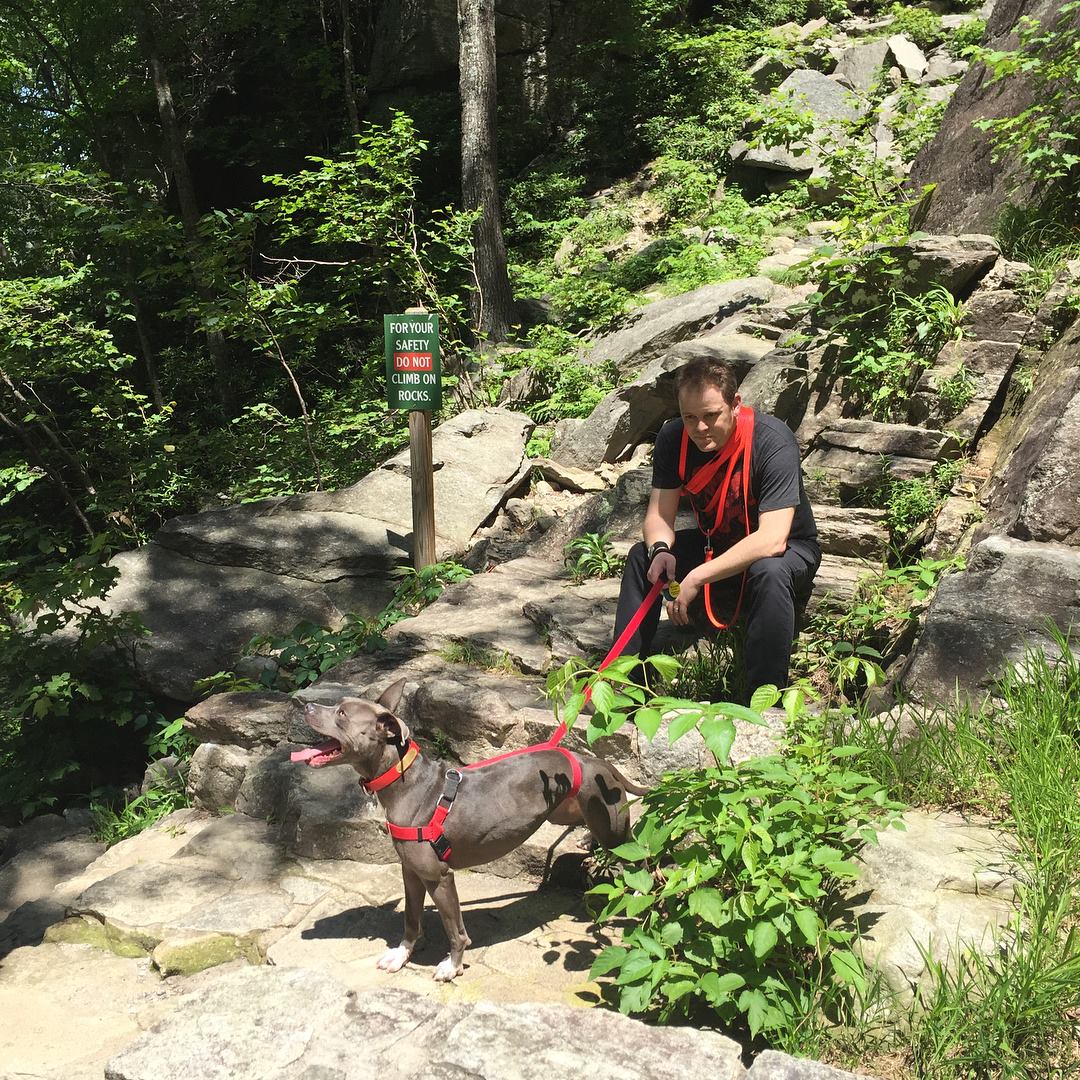
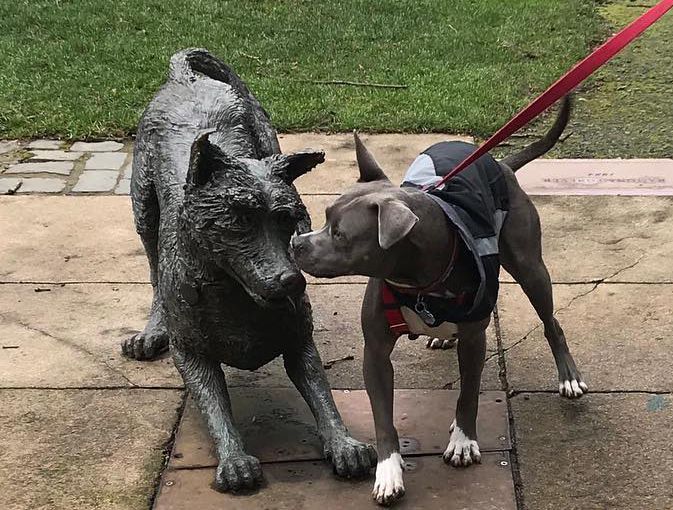
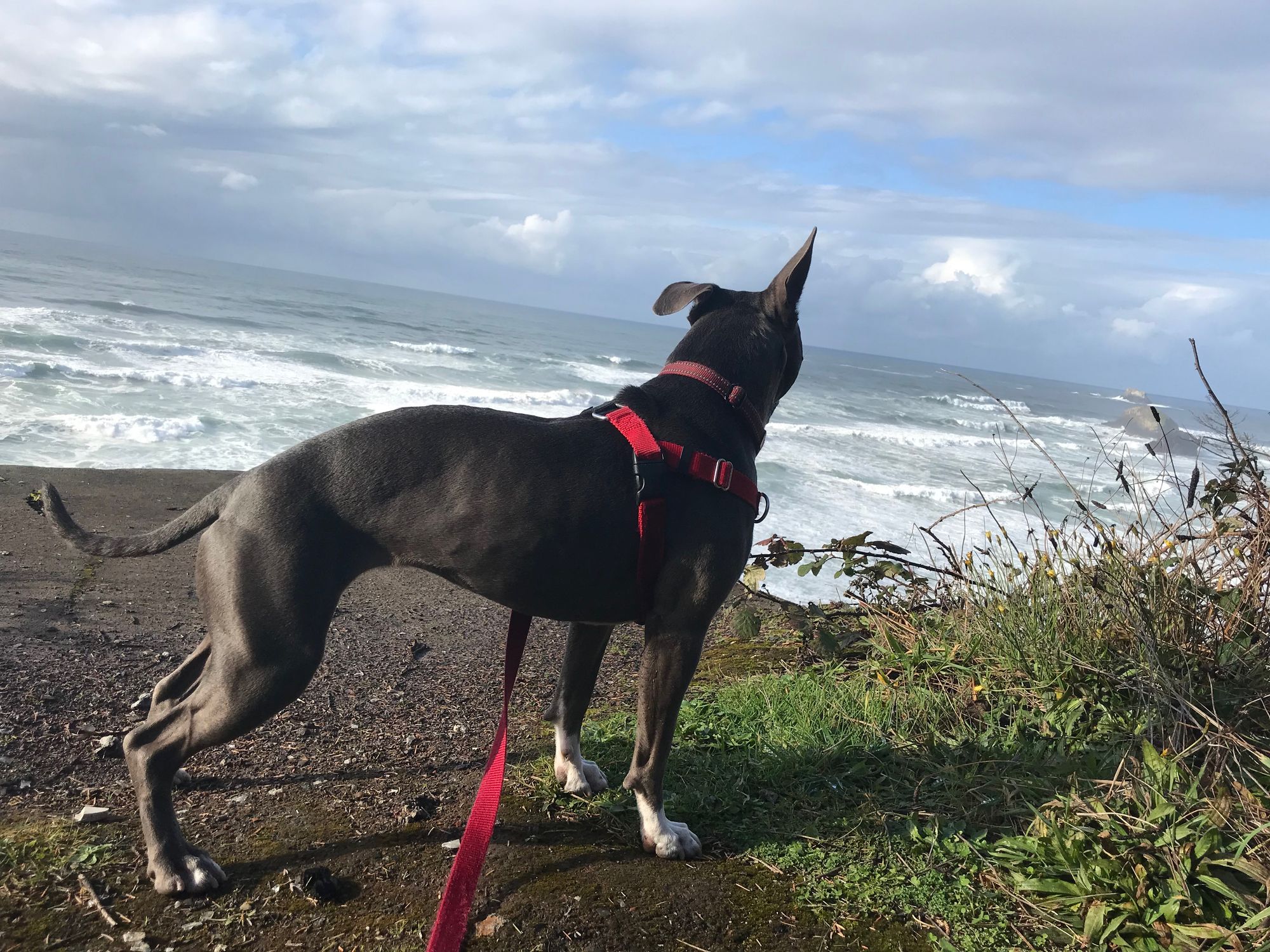

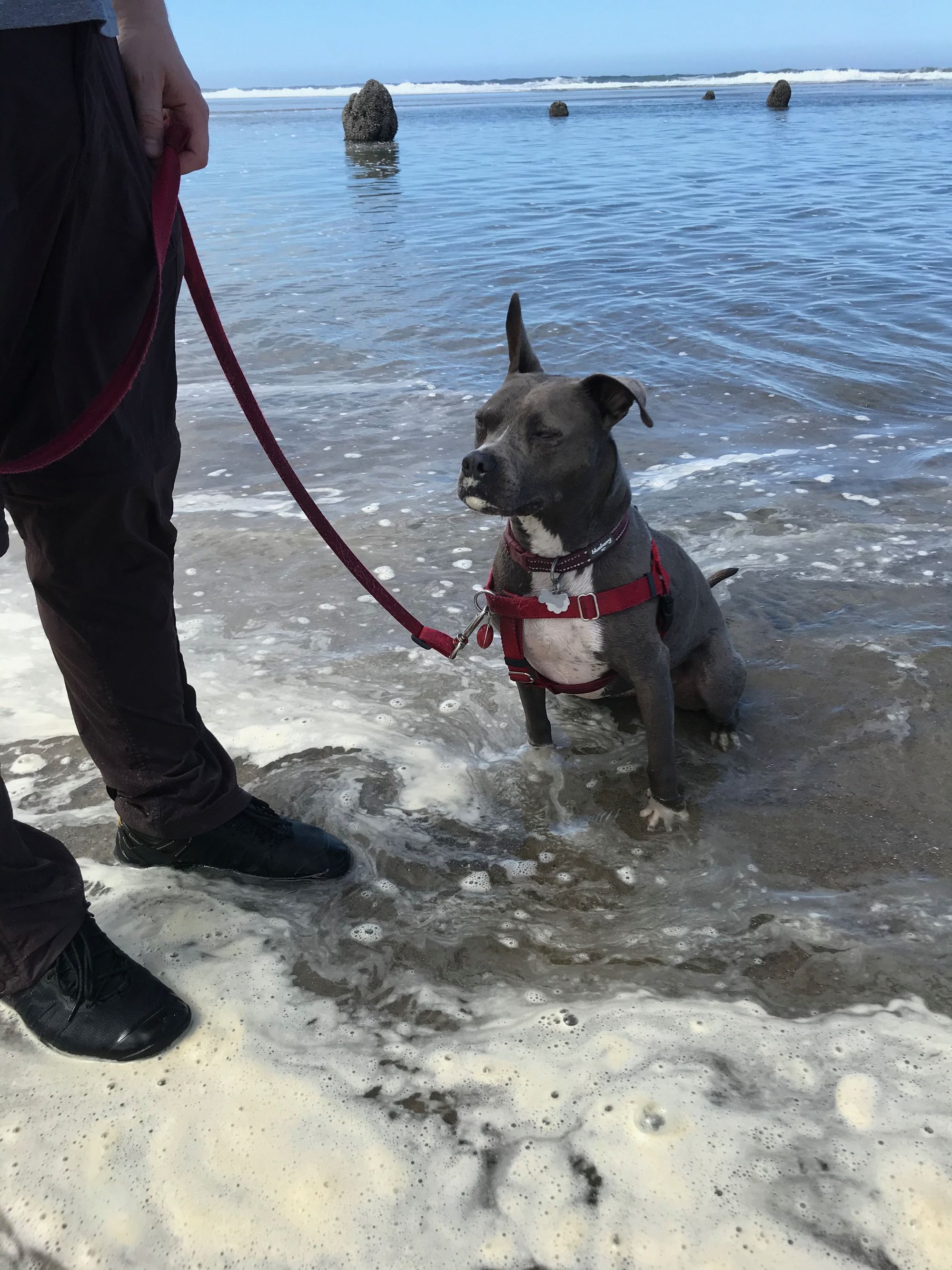



Postscript:
Both mornings that Essie was in the hospital, the Hellbender song “New Wounds” randomly played out of a playlist of 150+ songs. It was the song that kept coming up when I was worrying about her the most. While it’s a song that’s always resonated with me, it’s Essie’s now.
I’m including the lyrics below as a kind of memorial to her. But I want to note two things: a) I’m aware that there’s ableist language used within, and b) some of the lyrics don’t connect to my grief experience, but a lot do. It means something to me and makes me feel better.
I stay up all night counting cancers, as if the counting could cut them out.
The sun comes up and we struggle out on gimped up knees to face this bastard of a day.
The beauty is in the walking.
The destination disappoints.
You called to say that you were broken.
I stumbled home on swollen joints.
How long will we be locked in to the same old, lame old circle of friends, talking about what could have been or the things we should have done or the one that got away?
Endlessly.
When you break bones callouses grow.
Phantom limbs do phantom things.
Go through motions.
Time heals all wounds, to make more room for the new wounds.

